Scottish Marine and Freshwater Science Volume 5 Number 12: Strategic assessment of collision risk of Scottish offshore wind farms to migrating birds
Report to inform large scale indicative strategic assessments on the impact of offshore wind energy developments on birds.
3. Methods
Input data
Scottish Offshore Wind Farms
3.1. The following constructed, submitted and proposed offshore wind farms located in Scottish waters were included in this assessment:
- Beatrice;
- Moray Firth Round 3 (Telford, Stevenson and MacColl);
- European Offshore Wind Development Centre ( EOWDC);
- Neart na Gaoithe;
- Inch Cape;
- SeaGreen (Alpha and Bravo);
- Argyll Array;
- Islay; and
- Robin Rigg.
3.2. The wind farm dimensions and turbine specifications (as supplied by the respective developers or found online if no information was supplied) used for each site are provided in Table 1 and their locations are shown in Figure 1.
3.3. The key parameters used in the collision risk analysis varied for seabirds and non-seabird species. For seabirds the main parameters relate to turbine specifications (rotor dimensions, hub height, rotation speed, etc.). For non-seabird species the average wind farm footprint dimension ( i.e. average of width plus height) is used to estimate the proportional overlap of each wind farm and the migration front width. However, hub height is not used for non-seabird species. The steps involved in the collision analysis are provided below ( paragraph 3.109).
Table 1 - Scottish offshore wind farm data used in the strategic collision modelling
| Wind farm | Area (km2) | Max. footprint dimension (km) |
Latitude | No. turbines |
Perpendicular footprint dimension (at right angles to the max. dimension; km) |
Turbine rotation speed (average RPM) |
Rotor radius (m) |
Hub height (m. above msl) |
Proportion of time operational |
Max. blade width (m) |
Max. blade pitch (°) |
|---|---|---|---|---|---|---|---|---|---|---|---|
| Beatrice | 131.139 | 19.12 | 58.25 | 277 | 9 | 13 | 53.6 | 76.9 | 0.85 | 4.2 | 20 |
| Moray R3 Telford* |
93.3 | 15.16 | 58.25 | 139 | 7.21 | 11.68 | 65 | 85 | 0.8 | 4.2 | 30 |
| Moray R3 Stevenson* |
77.37 | 11.27 | 58.20 | 100 | 9.61 | 12.46 | 67.5 | 87.5 | 0.8 | 4.35 | 30 |
| Moray R3 MacColl* |
124.6 | 25.7 | 58.14 | 100 | 8.43 | 12.46 | 67.5 | 87.5 | 0.8 | 4.35 | 30 |
| EOWDC | 23.47 | 5.632 | 57.21 | 11 | 4.17 | 11 | 75 | 88 | 0.85 | 5 | 30 |
| Seagreen Alpha and Bravo |
391 | 17.3 | 56.59 | 150 | 27 | 10.7 | 83.5 | 123.75 | 0.85 | 5.4 | 10 |
| Inch Cape | 149.9 | 19.15 | 56.49 | 213 | 13.92 | 7.389 | 86 | 110.975 | 0.88 | 6 | 10 |
| Neart na Gaoithe |
83 | 13.2 | 56.27 | 73 | 8.2 | 12.1 | 63 | 90.84 | 0.84 | 4.5 | 30 |
| Argyll Array |
360.626 | 32.327 | 56.41 | 300 | 22.977 | 13 | 60 | 83.65 | 0.85 | 4.2 | 10 |
| Islay | 131 | 17.5 | 55.78 | 117 | 10.5 | 12.1 | 61 | 84.17 | 0.85 | 4.2 | 20 |
| Robin Rigg | 18 | 5.1 | 54.76 | 60 | 4 | 13 | 45 | 77.25 | 0.85 | 4.2 | 20 |
* Moray Firth Round 3 site
Figure 1 - Locations of Scottish offshore wind farm sites (from Crown Estate offshore wind farm map, last updated 1 st March 2013)
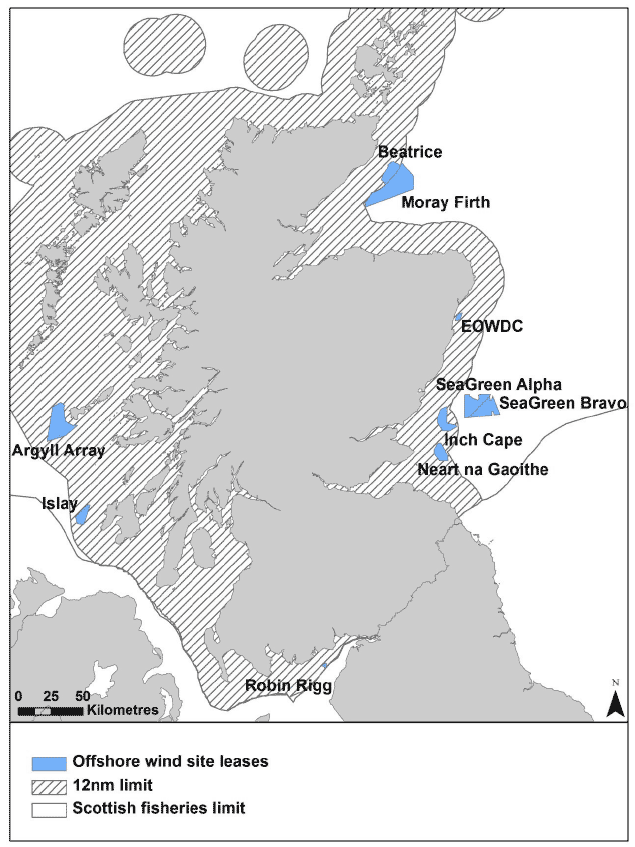
Review of seabird migration
3.4. For the purposes of this study, 'seabirds' were defined as divers, petrels, gannets, cormorants, skuas, gulls, terns and auks. Other taxa that are sometimes considered along with seabirds (grebes and phalaropes) are grouped with waterfowl and shorebirds respectively for this project.
3.5. Several seabird species have been scoped out from further analysis because their numbers migrating through Scottish waters represent less than 1% of the relevant population, and so impacts of offshore wind farm collision mortality would be negligible at the population level. Based on data compiled in Forrester et al. (2007) this applied to yellow-billed diver Gavia adamsii, Sabine's gull Xema sabini, Mediterranean gull Larus melanocephalus, Iceland gull Larus glaucoides, glaucous gull Larus hyperboreus, black tern Chlidonias niger, roseate tern Sterna dougallii, and little auk Alle alle. Several seabird species have been scoped out from further analysis because they fly only at heights below collision risk height, so will be at no risk of collision with offshore wind turbine blades. Based on data in Furness et al. (2013) this applied to Manx shearwater Puffinus puffinus, Cory's shearwater Calonectris diomedea, great shearwater Puffinus gravis and sooty shearwater Puffinus griseus. This left a total of 27 seabird species where analysis of collision risk for migrating populations seemed appropriate. These species are considered in turn below (see species accounts).
Population estimates
3.6. Numbers were primarily derived from Forrester et al. (2007) and agreed with the project's Steering Committee. An excel spreadsheet detailing the population estimates and sources for each species accompanies this report. Some numbers were cited explicitly by Forrester et al. Where a range of estimates was given a precautionary approach has been taken by using the higher estimate, unless it has been stated in the text that this estimate is unlikely in which case the mean was used. Some species were estimated from the text. In the case of kittiwake for example Forrester et al. state clearly that all Scottish kittiwakes disperse through Scottish waters in autumn and return in spring and that rather few 'foreign' kittiwakes visit Scottish waters so numbers primarily represent Scottish birds. There are an estimated 280,000 pairs breeding in Scotland so this is 560,000 breeding adults. There will be similar numbers of juvenile and immature birds so that totals approximately 1 million birds. Note this estimate is rounded to 1 million, not 999,999 birds. So there is around 1 million, not 0 million and not 3 million. Exactly the same approach applied for guillemot, razorbill and puffin. This method makes the broad assumption that seabird populations consist of approximately similar numbers of breeding adults and birds in younger age classes. That assumption is reasonable for species which mature at several years old and have high survival rates (as is the case for kittiwake, guillemot, razorbill and puffin) but would need to be adjusted if it were to be applied for short-lived seabirds that start to breed at an unusually young age, where immatures will form a smaller part of the total population.
Migration routes
3.7. For these seabird species migration tends to occur in bands along the coast. For the purposes of this project, five migration bands were defined:
- 0 - 10 km offshore;
- 0 - 20 km offshore;
- 0 - 40 km offshore;
- 0 - 60 km offshore; and
- 1 - 60 km offshore.
3.8. Each seabird species was assigned to one of the above migration bands, on the basis of observations from coastal watches and offshore surveys. Opinions used to assign bands for seabird species were those expressed in Forrester et al. (2007) combined with judgements based on knowledge of Bob Furness and Mark Trinder, supplemented by expert advice from Scottish seawatching experts: Chris McInerny and Bernie Zonfrillo. It is possible that on occasions some birds go outside their normal migration bands. It is also reported, for example, that terns and various other seabirds occasionally migrate overland from east to west Scotland ( e.g. across the central belt or down the Caledonian canal). Setting typical bands will never account for every bird but should normally account for most of the population.
3.9. Seabirds are unlikely to follow the coastline closely at all times, and this is especially likely whilst crossing the mouths of inlets and bays. This was acknowledged in the assessment by using three alternative suites of the coastal strips listed above. The difference between each was determined by the proximity of the inner boundary ( i.e. 0 km) to the coast. The inner boundary of the first suite of coastal bands (hereafter called 'near') followed the shoreline, until the opposite coasts of an inlet were less than around 20km apart. At this point it was assumed that migrating seabirds would follow a straight line across the inlet to the opposite side. The third suite of coastal bands ('far') was derived using the same approach, however seabirds were assumed to cut the corner of an inlet much earlier when the opposite sides were around 100km apart. An intermediate suite off bands was also specified ('mid') which was effectively half way between the near and far options. Having established the inner edge for each suite of coastal bands, the outer edges ( i.e. at 10/20/40/60 km) were simply plotted as the distance offshore from the inner edge. These migration bands are shown in Figures 2 to 4 and described for each seabird species below. Note that the 1-60km band was omitted from these figures for clarity.
Figure 2 - Near coast seabird migration patterns. Note that the bands are cumulative in width and not adjacent as this figure implies. Thus the 0-20 km buffer includes the 0-10 buffer, the 0-40 km buffer includes both the 0-10km and the 0-20 km buffers, etc.
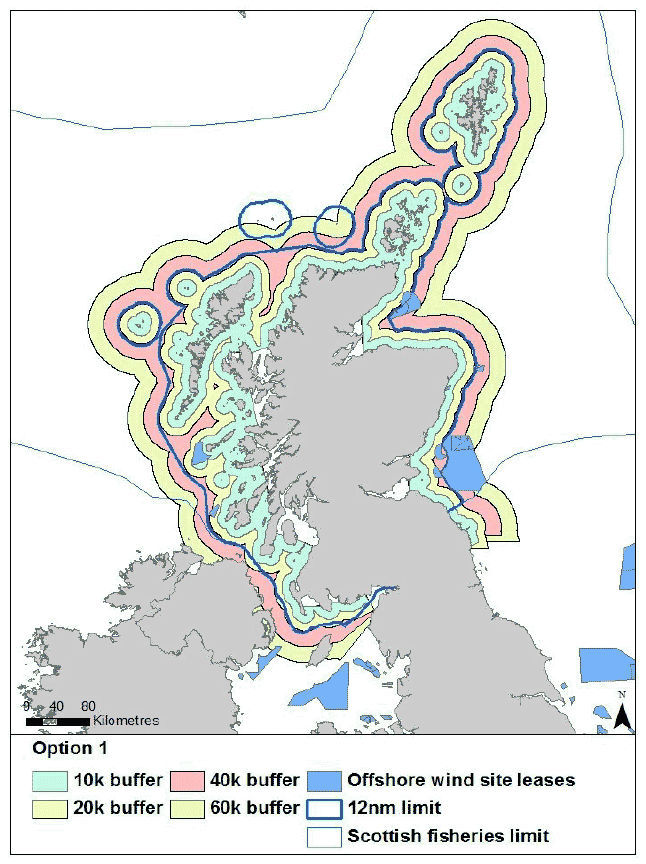
Figure 3 - Mid coastal distance seabird migration patterns. Note that the bands are cumulative in width and not adjacent as this figure implies. Thus the 0-20 km buffer includes the 0-10 buffer, the 0-40 km buffer includes both the 0-10km and the 0-20 km buffers, etc.
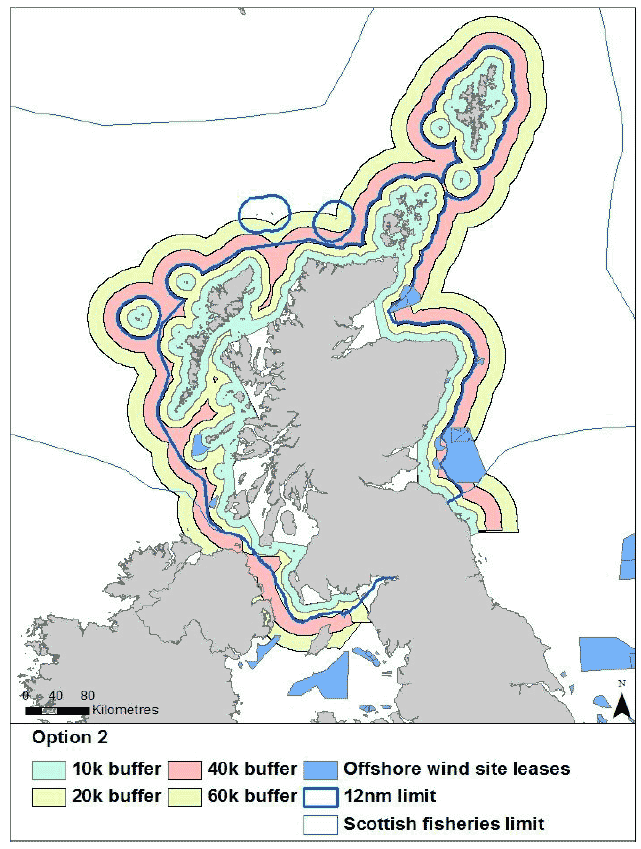
Figure 4 - Far coastal distance seabird migration patterns. Note that the bands are cumulative in width and not adjacent as this figure implies. Thus the 0-20 km buffer includes the 0-10 buffer, the 0-40 km buffer includes both the 0-10km and the 0-20 km buffers, etc.
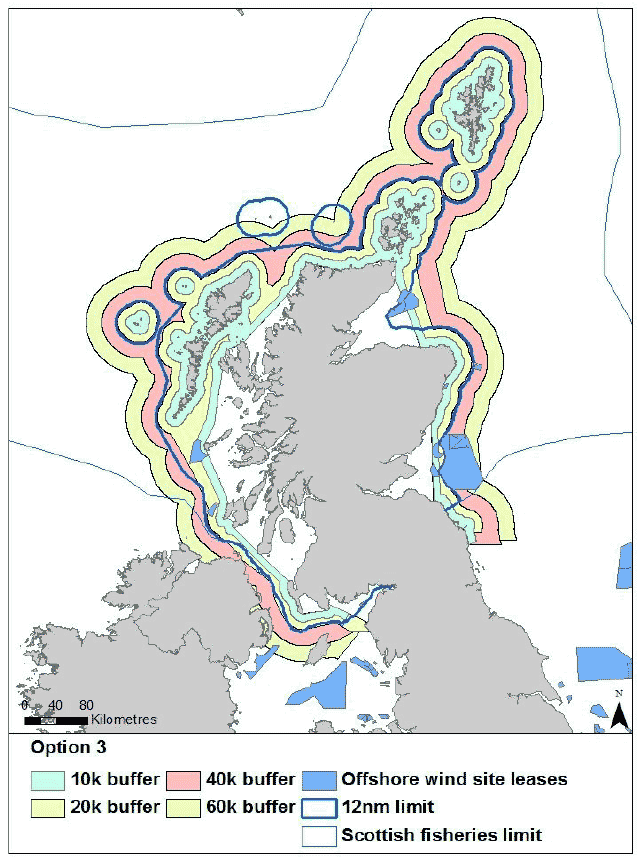
Seabird species accounts
Red-throated diver Gavia stellata
3.10. Some 935 to 1,500 pairs of red-throated diver breed in Scotland from April to September (Forrester et al. 2007). Most of these Scottish breeding birds are thought to migrate to wintering areas from Scottish coasts to France. Some birds from Scandinavia come to winter in Scottish coastal waters, and there may be some from Iceland and Greenland although this is uncertain (Wernham et al. 2002). The Scottish wintering population is thought to be around 2,270 birds (Forrester et al. 2007). Spring migration through Scottish waters is mainly in April and May, and may involve around 10,000 birds, with about 3,000 returning to Scottish breeding sites and about 7,000 moving through Scottish waters to Scandinavian breeding areas (Forrester et al. 2007). Autumn migration, in September and October, probably involves similar numbers from these two populations. Red-throated diver tend to prefer relatively sheltered waters in the lee of islands, in sea lochs, large estuaries, and coastal bays, being most common along shores with soft substrates (Forrester et al. 2007). Migration is thought to occur in a coastal band from 0-20 km from shore, with Scandinavian birds most likely occurring predominantly on the east coast of Scotland and Scottish birds passing along both east and west coasts, but predominantly the west coast given that most breeding sites are in NW Scotland or the Northern Isles (Wernham et al. 2002). The tendency for red-throated diver numbers in winter to be higher off the east coast of Scotland than off the west (Forrester et al. 2007) would be consistent with east coast sites being predominantly occupied by Scandinavian birds. Red-throated diver migration is most obvious off headlands such as at Peterhead, Frenchman's Rocks (Islay), or Fife Ness, indicating that passage occurring in a band offshore tends to be concentrated around headlands but occurs in a broader band off linear coastlines (Forrester et al. 2007). It is estimated that approximately 2% fly at collision risk height (Cook et al. 2012). Biogeographic population estimates are 10,000 pairs breeding in Europe, and 150,000-450,000 individuals wintering in NW Europe (Wetlands International 2012; Wright et al. 2012). Very large numbers of red-throated diver migrate from breeding areas in the Baltic and further east, through Danish waters into the eastern North Sea, and probably some move on from there to southern England. Those birds pass several Danish offshore wind farms and the possible impact of displacement from foraging has been modelled for birds in that population (Topping & Petersen 2011; Danish Energy Agency 2013). Collision risk, considered to be less than displacement risk for this species, was not included in the model (Topping and Petersen 2011).
Black-throated diver Gavia arctica
3.11. About 200 pairs breed in Scotland from April to August (Forrester et al. 2007). Most of these birds are thought to migrate only short distances to winter off the Scottish coast, but ringing has provided very little detail about their migrations (Wernham et al. 2002). The 700-800 birds wintering off Scotland are thought to be of local breeding origin, with few birds arriving in Scottish waters from overseas (Wernham et al. 2002). Thus spring passage, in March to May, may involve a total of around 1,000 birds, most returning to Scottish freshwater breeding sites from Scottish coastal wintering areas, and possibly a small proportion migrating to Scandinavian breeding areas (Forrester et al. 2007). Autumn migration in September and October involves return of birds from freshwater breeding sites to coastal areas, with many birds moving southwards from the Highlands to winter off SW Scotland and SE Scotland. There are probably similar numbers on each side of the country, although there is also a major wintering area in Scapa Flow with around 50 birds (Forrester et al. 2007, Dawson et al. 2009). Black-throated diver mostly breed in NW mainland Scotland, so migration to wintering areas is likely to involve similar numbers passing along the west and east coasts of Scotland. Most black-throated diver tend to occur near to shore, so probably migrate in a band from 0 to 20 km from the coast (Forrester et al. 2007). It is estimated that approximately 0.1% fly at collision risk height (Cook et al. 2012). Biogeographic population estimates are 24,000 pairs breeding in Europe, and 250,000-500,000 individuals wintering in Northern Europe (Wetlands International 2012; Wright et al. 2012).
Great northern diver Gavia immer
3.12. No great northern diver breed in Scotland. About 1,000 to 3,000 birds winter in Scottish waters (Forrester et al. 2007). About 3,000 birds arrive in Scottish waters in September and October from breeding populations in Greenland, Iceland, and Canada, with some (but relatively few) of these moving on to wintering areas beyond Scotland (Forrester et al. 2007). Biometrics of birds killed by oil pollution in Shetland suggested that their origins were 45% from Greenland/Baffin Island, 45% from Iceland and 10% from mainland Canada (Weir et al. 1996). In spring, in April and May, most great northern divers return to their breeding areas but a few remain in Scotland as summering non-breeders. Most great northern diver wintering in Scottish waters occur off west Scotland (including the Western Isles) or around the Northern Isles, with much smaller numbers along the east coast of Scotland (Forrester et al. 2007). Great northern diver tend to winter along more exposed coastline than preferred by red-throated diver and black-throated diver, and tend to occur at greater distances offshore than the two smaller species (Forrester et al. 2007). Their migrations are also less often detected by sea watching (Forrester et al. 2007), which is consistent with these birds tending to be further offshore. For this study we have assumed that their migration may occur in a wider band than that of the smaller species, with birds distributed between 0 and 40 km from the coast. No detailed flight height data are available, therefore the percentage for red-throated diver (2%; Cook et al. 2012) has been used here. Biogeographic population estimates are >25,000 pairs breeding in Canada, Greenland and Iceland, and 60,000 individuals wintering in the NE Atlantic (del Hoyo et al. 1992; Wetlands International 2012).
Northern fulmar Fulmarus glacialis
3.13. About 500,000 pairs of northern fulmar breed in Scotland (Mitchell et al. 2004; Forrester et al. 2007). Fulmar begin to occupy nest sites in November-December and numbers on cliffs in colonies increase to a peak around February, some weeks before egg laying (Forrester et al. 2007). Birds attend the colonies until September, though migration of failed breeders and immature birds starts to occur before then. There may be around 1 million fulmar in Scottish waters in winter, mostly offshore (Forrester et al. 2007). Autumn migration, peaking in October, may involve around 1 million birds passing through Scottish coastal waters from breeding cliffs out into pelagic waters, but the majority of these birds are thought to be Scottish birds, with a relatively small number coming into Scottish waters from Iceland (Wernham et al. 2002; Forrester et al. 2007). Spring migration back to colonies in Scotland occurs very early, in November to January. Most Scottish fulmar breed in NW Scotland, and the Northern Isles. Migrations can involve movements to areas as far as Newfoundland and northern Russia in the Barents Sea (Wernham et al. 2002), but it is unclear how many Scottish fulmar leave Scottish waters during winter. Fulmar migrations appear to involve dispersal from colonies directly into pelagic waters (Wernham et al. 2002) rather than migrations along Scottish coasts. Fulmar densities tend to be highest in the 'shelf-break' waters off NW Scotland, although large numbers can aggregate at trawler fleets over the continental shelf (Stone et al. 1995). Migration through Scottish waters is likely to track coastlines but in a broad band from 0 to 60 km from shore (Furness et al. 2013). It is estimated that approximately 0.2% fly at collision risk height (Cook et al. 2012). Biogeographic population estimates are 3-4 million pairs breeding in Europe, and 10 million individuals wintering in the NE Atlantic (Mitchell et al. 2004; Wetlands International 2012; Wright et al. 2012).
European storm-petrel Hydrobates pelagicus
3.14. About 32,000 pairs of European storm-petrel breed in Scotland in colonies distributed from the Mull of Kintyre to Shetland along the west side of Scotland (Mitchell et al. 2004; Forrester et al. 2007). Birds re-occupy nest sites in May and can be attending the colony until October. None remain in Scottish waters in winter (Wernham et al. 2002). Autumn migration occurs from about July to October with perhaps around 200,000 birds passing through Scottish waters (Forrester et al. 2007). These include local breeders departing to the South Atlantic, as well as breeders from Iceland, Faeroes and small numbers from Norway, and also associated immature birds from all these areas (Forrester et al. 2007). This estimate of numbers is reasonably consistent with the suggestion that some 123,000 European storm-petrels visit Shetland as 'wandering non-breeders' each summer (Fowler and Hounsome 1998). Migration through Scottish waters is likely to track coastlines but in a broad band from 0 to 60 km from shore (Furness et al. 2013). Almost all European storm-petrel migrate along the west side of Britain, with very few entering the North Sea. Return migration in spring probably involves smaller numbers, predominantly birds returning to British colonies but some passing further north, and may number around 100,000 birds passing through the area in April-May. Again, almost all movement is to the west of Scotland, with hardly any birds entering the North Sea except in Shetland waters. It is thought approximately 1% fly at collision risk height (Cook et al. 2012). Biogeographic population estimates are 500,000 pairs breeding in Europe, but no individuals wintering in European waters (Mitchell et al. 2004; Wetlands International 2012; Wright et al. 2012).
Leach's storm-petrel Oceanodroma leucorhoa
3.15. About 48,000 pairs of Leach's storm-petrel breed in Scotland (Mitchell et al. 2004; Forrester et al. 2007). Birds re-occupy nest sites in April and can be attending the colony until September. None remain in Scottish waters in winter. Autumn migration occurs in September and October with around 500,000 birds passing through Scottish waters (Forrester et al. 2007). These include local breeders departing to the South Atlantic, as well as breeders from Iceland, Faeroes and probably also from eastern Canada, and also associated immature birds from all these areas (Wernham et al. 2002). Migration through Scottish waters is likely to track coastlines but in a broad band from 0 to 60 km from shore (Furness et al. 2013). Return migration in spring probably involves smaller numbers, predominantly birds returning to British colonies but some passing further north, and may number around 200,000 birds passing through the area in April (Forrester et al. 2007). Almost all migration of Leach's storm-petrel through Scottish waters has been observed in SW Scotland or off the Western Isles (Forrester et al. 2007). Very few birds of this species enter the North Sea, and the species is very rarely seen in Orkney waters even during autumn migration (Orkney Bird Reports). It is thought approximately 1% fly at collision risk height (Cook et al. 2012). Biogeographic population estimates are 200,000 pairs breeding in Europe plus some 5 million pairs in Eastern Canada, but no individuals wintering in European waters (Mitchell et al. 2004; Wetlands International 2012; Wright et al. 2012).
Northern gannet Morus bassanus
3.16. About 182,500 pairs of northern gannet breed in Scotland (Forrester et al. 2007). Birds mostly re-occupy nest sites in March and can be attending the colony until September. Only about 5,000 gannets are in Scottish waters in winter and many of those are probably from Norwegian colonies (Fort et al. 2012). Autumn migration occurs in October-November with around 600,000 birds passing through Scottish waters. These include local breeders departing to southern Europe and West Africa (Garthe et al. 2012), as well as breeders from Iceland, Faeroes and Norway (Wernham et al. 2002), and also associated immature birds (Votier et al. 2011) from all these areas. Migration through Scottish waters is likely to track coastlines but in a broad band from 0 to 40 km from shore (Furness et al. 2013). Return migration in spring probably involves smaller numbers, predominantly birds returning to British colonies, and may number around 400,000 birds passing through the area in January-March. Although southward bound birds in autumn include migrants along the east and west coasts of Scotland, in spring the majority of birds that are returning to North Sea colonies appear to do so via the West Coast and Pentland Firth, thereby largely avoiding the English channel ( WWT Consulting 2012). It is estimated that approximately 9.6% fly at collision risk height (Cook et al. 2012). Biogeographic population estimates are 300,000 pairs breeding in Europe, and 800,000 individuals wintering in European waters (Mitchell et al. 2004; Wetlands International 2012; Wright et al. 2012).
Great cormorant Phalacrocorax carbo
3.17. About 3,600 pairs of great cormorant breed in Scotland (Mitchell et al. 2004; Forrester et al. 2007). Birds re-occupy nest sites in April but usually leave the colonies by the end of July. About 10,000 are in Scottish waters in winter. Autumn migration occurs in August-September with around 10,000 birds passing through Scottish waters at this time (Forrester et al. 2007). These are almost exclusively local breeders (Wernham et al. 2002) departing short distances to wintering areas plus associated immature birds. Migration through Scottish waters is likely to track coastlines in a narrow band from 0 to 10 km from shore, with birds tending to move southwards to sheltered wintering areas such as Firth of Forth, Clyde, and Solway Firth (Forrester et al. 2007). Return migration in spring probably involves smaller numbers, predominantly birds returning to Scottish colonies, and may number around 7,000 birds passing through the area in March-April. Cook et al. (2012) were unable to generate an estimate for the percentage of time this species flies at collision height, therefore the rate for shag (12.4%) has been used. Biogeographic population estimates are 52,000 pairs of subspecies P. c. carbo breeding, and 150,000 individuals of P. c. carbo wintering in Western Europe (Mitchell et al. 2004; Wetlands International 2012; Wright et al. 2012).
European shag Phalacrocorax aristotelis
3.18. About 25,000 pairs of European shag bred in Scotland around 2000 (Mitchell et al. 2004), although monitoring indicates that numbers have declined by about 47% from 1985 to 2011 (Foster and Marrs 2012). Birds re-occupy nest sites in March and can be attending the colony until July/August, some staying longer when conditions permit protracted breeding. About 70,000 are in Scottish waters in winter (Forrester et al. 2007). Autumn migration occurs around August with around 70,000 birds passing through Scottish waters, though only over short distances predominantly slightly to the south of breeding colonies (Galbraith et al. 1986; Wernham et al. 2002). Migrants are almost exclusively local breeders plus associated immature birds (Galbraith et al. 1986; Forrester et al. 2007). Migration through Scottish waters is likely to track coastlines in a narrow band from 0 to 10 km from shore, tending to move from exposed coasts to more sheltered coasts. Return migration in spring probably involves similar numbers, almost exclusively birds returning to Scottish colonies, and may number around 70,000 birds passing through the area around February. It is estimated that approximately 12.4% fly at collision risk height (Cook et al. 2012). Biogeographic population estimates are 73,000 pairs breeding in Europe, and 250,000 individuals wintering in European waters (Mitchell et al. 2004; Wetlands International 2012; Wright et al. 2012).
Arctic skua Stercorarius parasiticus
3.19. About 2,100 pairs of Arctic skua bred in Scotland around 2000 (Mitchell et al. 2004), although monitoring indicates that numbers have declined by about 74% from 1985 to 2011 (Foster and Marrs 2012). Birds re-occupy nest sites in May and can be attending the colony until late July. None remain in Scottish waters in winter. Autumn migration occurs in August-September with around 10,000 birds passing through Scottish waters, with similar numbers moving south along the North Sea coast and along the western seaboard of the British Isles (Forrester et al. 2007). These include local breeders departing to the South Atlantic, as well as breeders from Iceland, Faeroes, Norway and the Arctic, and also associated immature birds from all these areas (Forrester et al. 2007). Migration through Scottish waters is likely to track coastlines but in a relatively narrow band from 0 to 20 km from shore (Taylor 1979; Wernham et al. 2002). Return migration in spring probably involves smaller numbers and mostly along the western seaboard with few birds in the North Sea in spring, and may number around 5,000 birds passing through the area in April-May (Forrester et al. 2007). It is estimated that approximately 3.8% fly at collision risk height (Cook et al. 2013). Biogeographic population estimates are 20,000 pairs breeding in the countries bordering the northern NE Atlantic and Baltic, but no individuals wintering in the region (Mitchell et al. 2004; Wetlands International 2012; Wright et al. 2012).
Great skua Stercorarius skua
3.20. About 10,000 pairs of Great skua breed in Scotland (Mitchell et al. 2004), mostly in Shetland and Orkney (Forrester et al. 2007). Birds re-occupy nest sites in May and can be attending the colony until late July (Klomp and Furness 1992). None remain in Scottish waters in winter. Autumn migration occurs in August-September with around 30,000 birds passing through Scottish waters, with probably similar numbers moving down the east and west sides of the country (Forrester et al. 2007). These include local breeders departing to southern Europe and West Africa, as well as breeders from Iceland, Faeroes and small numbers from Norway, and also associated immature birds from all these areas (Magnusdottir et al. 2012). Migration through Scottish waters is likely to track coastlines but in a band from 0 to 40 km from shore. Return migration in spring, predominantly birds returning to British colonies but also birds returning to Iceland, Faeroes and Norway, may number around 30,000 birds passing through the area in April-May (Forrester et al. 2007), with more birds moving up the west side rather than through the North Sea (Magnusdottir et al. 2012). It is estimated that approximately 4.3% fly at collision risk height (Cook et al. 2012). Biogeographic population estimates are 16,000 pairs (Global population for the species), and 50,000 individuals (Global population for the species) (Mitchell et al. 2004; Wetlands International 2012; Wright et al. 2012).
Pomarine skua Stercorarius pomarinus
3.21. No pomarine skua breed in Scotland. Possibly around 10 birds winter in Scottish waters (Forrester et al. 2007). Autumn migration occurs in September-October with around 2,000 birds passing through Scottish waters, probably with similar numbers passing along the east and west coasts. These include breeding birds from Arctic Ocean coasts and Arctic tundra though perhaps mostly from the European part of the Arctic, and also associated immature birds from these areas (Forrester et al. 2007). Migration through Scottish waters is likely to track coastlines but in a broad band from 0 to 40 km from shore. Return migration in spring may number around 3,000 birds passing through the area in April-May, with the vast majority of these birds passing to the west of Scotland (Forrester et al. 2007). There is no species specific estimate for the proportion of flying time spent at rotor height for this species, thus on the basis of the values for Arctic skua and great skua (3.8 and 4.3 respectively) a value of 5% has been used (although it is worth noting that during migration this species may sometimes pass through at considerable heights well above the rotor swept zone of offshore turbines, especially during the relatively rapid passage that occurs in spring). Biogeographic population estimates suggest 2,000 pairs breeding in Arctic Europe, but numbers wintering in the region are unknown though probably small (del Hoyo et al. 1996; Mitchell et al. 2004; Wetlands International 2012).
Long-tailed skua Stercorarius longicaudus
3.22. No Long-tailed skua breed in Scotland although very occasionally a bird or a pair has held territory (Forrester et al. 2007). None remain in Scottish waters in winter. Autumn migration occurs in August-September with around 1,000 birds passing through Scottish waters, with similar numbers to the east and west of Scotland (Forrester et al. 2007). These include breeding birds from Scandinavia and the Arctic, and also associated immature birds from these areas (Forrester et al. 2007). Migration through Scottish waters is likely to track coastlines but in a broad band from 1 to 60 km from shore. Return migration in spring probably involves around 1,000 birds passing through the area mostly in May, and with almost all birds moving up the west side of Scotland and very few seen in the North Sea during spring (Forrester et al. 2007). There is no species specific estimate for the proportion of flying time spent at rotor height for this species, thus on the basis of the values for Arctic skua and great skua (3.8 and 4.3 respectively) a value of 5% has been used (although it is worth noting that during migration this species may sometimes pass through at considerable heights well above the rotor swept zone of offshore turbines, especially during the relatively rapid passage that occurs in spring). Biogeographic population estimates are 5,000 pairs breeding in Europe, but no individuals wintering in the region (del Hoyo et al. 1996; Mitchell et al. 2004; Wetlands International 2012).
Black-legged kittiwake Rissa tridactyla
3.23. About 280,000 pairs of black-legged kittiwake bred in Scotland around 2000 (Mitchell et al. 2004), although monitoring indicates that breeding numbers in Scotland have declined by about 66% from 1985 to 2011 (Foster and Marrs 2012). Birds re-occupy nest sites in April and can be attending the colony until late July (Wernham et al. 2002). About 10,000 individuals are in Scottish waters in winter (Forrester et al. 2007). Autumn migration occurs from about August to October with around 1,000,000 birds passing through Scottish waters, with probably similar numbers passing southwards along east and west sides of the country (Forrester et al. 2007). These include local breeders departing to the Atlantic, as well as breeders from Iceland, Faeroes and Norway, and also associated immature birds from these areas (Frederiksen et al. 2012). Migration through Scottish waters is likely to track coastlines but in a broad band from 1 to 60 km from shore. Return migration in spring probably involves similar numbers, passing through the area in March, possibly with a higher proportion along the west side of the country although this is less well known than for skuas and gannets (Forrester et al. 2007). It is estimated that approximately 15.7% fly at collision risk height (Cook et al. 2012). Biogeographic population estimates are 2.5 million pairs breeding in Europe, and 10 million wintering in the North Atlantic (Mitchell et al. 2004; Wetlands International 2012; Wright et al. 2012).
Black-headed gull Chroicocephalus ridibundus
3.24. About 43,000 pairs of black-headed gull breed in Scotland (Mitchell et al. 2004; Forrester et al. 2007). Birds re-occupy nest sites in March and can be attending the colony until late July (Wernham et al. 2002). There are about 155,000 in Scotland in winter according to Forrester et al. (2007). Burton et al. (2013) suggest a wintering population of 199,682 (188,437-211,796) in terrestrial and coastal habitats in Scotland in 2003-04 and 2005-06. Autumn migration occurs in August-September with around 120,000 birds passing through Scottish waters. These include local breeders, as well as breeders from Scandinavia and Baltic States (MacKinnon and Coulson 1987; Forrester et al. 2007), and also associated immature birds from these areas. In contrast to many other seabirds that migrate parallel to the coast and in a band offshore from land, migration through Scottish waters is likely to be in a broad front between breeding areas and Scotland, with black-headed gulls predominantly wintering in terrestrial and estuarine areas (Burton et al. 2013). Return migration in spring probably involves similar numbers, predominantly birds returning to British colonies, and may number around 120,000 birds passing through the area in March-April (Forrester et al. 2007). It is likely that Scandinavian birds predominantly remain on the east coast of Scotland and that very few move across to west Scotland (MacKinnon and Coulson 1987). Birds migrating to and from the west of Scotland probably include some from Iceland (Wernham et al. 2002). It is estimated that approximately 7.9% of black-headed gull flight occurs at collision risk height (Cook et al. 2012). Biogeographic population estimates are 2 million pairs breeding in Europe, and 5 million individuals wintering in Europe (Mitchell et al. 2004; Wetlands International 2012; Wright et al. 2012).
Common gull Larus canus
3.25. About 48,000 pairs of Common gull breed in Scotland (Mitchell et al. 2004; Forrester et al. 2007). Birds re-occupy nest sites in April and can be attending the colony until late July. About 80,000 individuals are in Scotland in winter according to Forrester et al. (2007). Burton et al. (2013) suggest a wintering population of 200,296 (185,410-215,034) in Scotland in terrestrial and coastal habitats in 2003-04 and 2005-06. Autumn migration occurs in July-August with around 300,000 birds passing through Scottish waters. These include departing local breeders, as well as breeders from Scandinavia and Iceland, and also associated immature birds from these areas (Forrester et al. 2007). Migration through Scottish waters is likely to involve birds arriving on a broad front from breeding areas, then tracking coastlines but in a band from 0 to 20 km from shore. The majority of migrating common gull probably move south in autumn along the east side of Scotland. Scandinavian birds wintering in Scotland are most likely to be from northern Norway, whereas birds breeding in southern Scandinavia mainly move to eastern England (Wernham et al. 2002). Return migration in spring probably involves around 300,000 birds passing through the area in March-April, either to Scottish breeding areas, or to Scandinavia or Iceland (Forrester et al. 2007). It is estimated that approximately 22.9% fly at collision risk height (Cook et al. 2012). Biogeographic population estimates are 480,000 pairs breeding in Europe, and 1.2 million individuals wintering in Europe (Mitchell et al. 2004; Wetlands International 2012; Wright et al. 2012).
Little gull Hydrocoloeus minutus
3.26. No little gull breed in Scotland. About 400 birds from Fennoscandian breeding areas are in Scottish waters in winter (Forrester et al. 2007). Autumn migration occurs from about June to September with around 3,000 birds passing through Scottish waters. All of these birds are thought to originate from Fennoscandia (Forrester et al. 2007). Migration through Scottish waters is likely to occur on a broad front between southern Scandinavia and east Scotland, then tracking the east coastline southwards in a relatively narrow band from 0 to 20 km from shore. Return migration in spring probably involves smaller numbers, with perhaps around 400 birds passing through the area in March (Forrester et al. 2007). It is estimated that approximately 5.5% fly at collision risk height (Cook et al. 2012). Biogeographic population estimates are 25,000 pairs breeding in Europe, and over 100,000 individuals wintering in Europe (del Hoyo et al. 1996; Mitchell et al. 2004; Wetlands International 2012).
Lesser black-backed gull Larus fuscus
3.27. About 25,000 pairs of lesser black-backed gull breed in Scotland (Mitchell et al. 2004; Forrester et al. 2007). Birds re-occupy nest sites in March and can be attending the colony until August. Only about 600 individuals are in Scotland in winter according to Forrester et al. (2007). Burton et al. (2013) suggest a wintering population of 6,510 (5,742-7,294) in terrestrial and coastal habitats in Scotland in 2003-04 and 2005-06. Autumn migration occurs in September-October with around 80,000 birds passing through Scottish waters. These include local breeders departing to southern Europe and Africa (Wernham et al. 2002), but also some breeders from Iceland, and associated immature birds from these areas (Forrester et al. 2007). Migration of Icelandic birds through Scottish waters is likely to occur initially on a broad front between Iceland and northern Scotland, but then to track coastlines in a relatively narrow band from 0 to 20 km from shore. Return migration in spring probably involves smaller numbers, predominantly birds returning to British colonies, and may number around 50,000 birds passing through the area in March (Forrester et al. 2007). It is estimated that approximately 25.2% fly at collision risk height (Cook et al. 2012). Biogeographic population estimates are 180,000 pairs of subspecies L.f. graellsii breeding in Europe, and this breeding population is thought to amount to a total of 500,000 individuals of the graellsii subspecies (Mitchell et al. 2004; Wetlands International 2012; Wright et al. 2012).
Herring gull Larus argentatus
3.28. About 72,000 pairs of herring gull bred in Scotland around 2000 (Mitchell et al. 2004), although monitoring indicates that breeding numbers in Scotland have declined by about 58% from 1985 to 2011 (Foster and Marrs 2012). Birds re-occupy nest sites in March and can be attending the colony until August (Wernham et al. 2002). About 110,000 individuals are in Scotland in winter according to Forrester et al. (2007). Burton et al. (2013) suggest a wintering population of 273,058 (252,574-293,613) in terrestrial and coastal habitats in Scotland in 2003-04 and 2005-06. Autumn migration occurs in September-October with around 50,000 birds passing through Scottish waters. Although many Scottish breeders are resident, autumn migrants include some dispersing local breeders, as well as breeders from north Norway and northern Russia (Coulson et al. 1984a), and also associated immature birds. Migration through Scottish waters is likely to track coastlines but in a relatively narrow band from 0 to 20 km from shore. Autumn migration is predominantly along the east coast of Scotland, with birds in the west being particularly sedentary (ap Rheinallt et al. 2007), and apparently almost no Norwegian and Russian birds visiting the west coast of Scotland (Coulson et al. 1984a). Return migration in spring, predominantly birds returning to British colonies but with some birds returning to north Norway and Russia past the east coast of Scotland, may number around 50,000 birds passing through the area in January-March (Forrester et al. 2007). It is estimated that approximately 28.4% fly at collision risk height (Cook et al. 2012). Biogeographic population estimates are 750,000 pairs breeding in Europe, and 2 million individuals wintering in Europe (Mitchell et al. 2004; Wetlands International 2012; Wright et al. 2012).
Great black-backed gull Larus marinus
3.29. About 14,800 pairs of great black-backed gull bred in Scotland around 2000 (Mitchell et al. 2004), although monitoring indicates that breeding numbers in Scotland have declined by about 53% from 1985 to 2011 (Foster and Marrs 2012). Birds re-occupy nest sites in March and can be attending the colony until August. About 10,000 individuals are in Scotland in winter according to Forrester et al. (2007). Burton et al. (2013) suggest a wintering population of 18,113 (16,751-19,653) in terrestrial and coastal habitats in Scotland in 2003-04 and 2005-06. Autumn migration occurs in September-October with around 10,000 birds passing through Scottish waters (Forrester et al. 2007). These include some dispersing local breeders, as well as breeders from north Norway and Russia (Wernham et al. 2002), and also associated immature birds. Migration through Scottish waters is likely to track coastlines but in a relatively narrow band from 0 to 20 km from shore. Apparently birds arriving from north Norway and Russia remain on the east side of Scotland, rarely if ever crossing to the west coast (Coulson et al. 1984b). Nevertheless, a slight passage of great black-backed gulls in September-October has been reported from west coast seawatching sites such as Machrihanish Seabird Observatory (ap Rheinallt et al. 2007). Return migration in spring probably involves around 10,000 birds passing through the area in January-March, mostly northwards along the east coast of Scotland. It is estimated that approximately 33.1% fly at collision risk height (Cook et al. 2012). Biogeographic population estimates are 110,000 pairs breeding in Europe, and 300,000 individuals wintering in Europe (Mitchell et al. 2004; Wetlands International 2012; Wright et al. 2012).
Little tern Sternula albifrons
3.30. About 330 pairs of little tern breed in Scotland (Mitchell et al. 2004). Birds re-occupy nest sites in April and can be attending the colony until late July (Wernham et al. 2002). None remain in Scottish waters in winter. Autumn migration occurs in August with around 600 birds passing through Scottish waters. These are probably all local Scottish breeders and also associated immature birds departing to the south (Wernham et al. 2002). Migration through Scottish waters is likely to track coastlines in a narrow band from 0 to 10 km from shore. Given that relatively small numbers of little terns breed on the west coast of Scotland (Forrester et al. 2007), the majority of the birds will move along the east coast. Return migration in spring probably involves c. 600 birds passing through the area in April, with probably the majority of these birds moving northwards along the east coast. There is no species specific estimate for the proportion of time spent at collision height, therefore an estimate of 5% (similar to Arctic tern and Sandwich tern) has been used. Biogeographic population estimates are 20,000 pairs breeding in Europe, but no individuals wintering in Europe (Mitchell et al. 2004; Wetlands International 2012; Wright et al. 2012).
Sandwich tern Sterna sandvicensis
3.31. About 1,100 pairs of Sandwich tern bred in Scotland around 2000 (Mitchell et al. 2004), although monitoring indicates that breeding numbers in Scotland have declined by about 48% from 1985 to 2011 (Foster and Marrs 2012). Birds re-occupy nest sites in May and can be attending the colony until August (Wernham et al. 2002). None remain in Scottish waters in winter. Autumn migration occurs in August-September with around 5,000 birds passing through Scottish waters. These include local breeders departing to the South Atlantic, as well as breeders from colonies in the Baltic (Wernham et al. 2002), and associated immature birds from these areas. Migration through Scottish waters is likely to track coastlines in a narrow band from 0 to 10 km from shore (Wernham et al. 2002). Since virtually all breeders in Scotland are on the east coast it is likely that the vast majority of migrants move along the east coast rather than the west. However, small numbers of Sandwich tern do migrate along the west coast of Argyll, mostly in July-September (ap Rheinallt et al. 2007). Return migration in spring probably involves smaller numbers, predominantly birds returning to British colonies but with some birds moving towards the Baltic, and may number around 3,000 birds passing through the area in April-May. It is estimated that approximately 3.6% fly at collision risk height (Cook et al. 2012). Biogeographic population estimates are 75,000 pairs breeding in Europe, but no individuals wintering in Europe (Mitchell et al. 2004; Wetlands International 2012; Wright et al. 2012).
Common tern Sterna hirundo
3.32. About 4,800 pairs of common tern bred in Scotland around 2000 (Mitchell et al. 2004), although monitoring indicates that breeding numbers in Scotland have declined by about 43% from 1985 to 2011 (Foster and Marrs 2012). Birds re-occupy nest sites in May and can be attending the colony until late July. None remain in Scottish waters in winter. Autumn migration occurs in August-September with around 20,000 birds passing through Scottish waters. These include local breeders departing to the South Atlantic, as well as breeders from Scandinavia, and also associated immature birds from these areas. Migration through Scottish waters is likely to track coastlines in a narrow band from 0 to 10 km from shore (Wernham et al. 2002). Return migration in spring probably involves around 20,000 birds passing through the area in April. However, Wernham et al. (2002) suggest that spring migration may take many birds overland and they specifically comment on the paucity of sightings of northward migrating common terns in the Irish Sea in spring. It is estimated that approximately 12.7% fly at collision risk height (Cook et al. 20123). Biogeographic population estimates are 250,000 pairs breeding in Europe, but no individuals wintering in Europe (Mitchell et al. 2004; Wetlands International 2012; Wright et al. 2012).
Arctic tern Sterna paradisaea
3.33. About 47,000 pairs of Arctic tern bred in Scotland around 2000 (Mitchell et al. 2004), although monitoring indicates that breeding numbers in Scotland have declined by about 72% from 1985 to 2011 (Foster and Marrs 2012). Birds re-occupy nest sites in May and can be attending the colony until July. None remain in Scottish waters in winter. Autumn migration occurs in August-September with around 200,000 birds passing through Scottish waters. These include local breeders departing to the South Atlantic, as well as breeders from Iceland, Faeroes and Fennoscandia, and also associated immature birds from all these areas. It is also possible that some birds from North America migrate through Scottish waters (Wernham et al. 2002). However, recent studies deploying data loggers have tracked migrations of individual Arctic terns from breeding sites in east Greenland and Iceland, and found that those birds all moved south through the central North Atlantic, not reaching Europe until at the latitude of Iberia (Egevang et al. 2010). Migration of Scottish and Scandinavian Arctic terns through Scottish waters is likely to track coastlines in a narrow band from 0 to 20 km from shore (Wernham et al. 2002 point out that this species migrates along coastlines, but often migrates further from the coast than does the common tern). Return migration in spring probably involves around 200,000 birds passing through the area in April-May, some returning to Scottish colonies, but many passing through towards Iceland or Fennoscandia. It is estimated that approximately 2.8% fly at collision risk height (Cook et al. 2012). Biogeographic population estimates are 520,000 pairs breeding in Europe, but no individuals wintering in Europe (Mitchell et al. 2004; Wetlands International 2012; Wright et al. 2012).
Common guillemot Uria aalge
3.34. About 800,000 pairs of common guillemot bred in Scotland around 2000 (Mitchell et al. 2004; Forrester et al. 2007), although monitoring indicates that breeding numbers in Scotland have declined by about 24% from 1985 to 2011 (Foster and Marrs 2012). Birds re-occupy nest sites as early as in January but sometimes not until March, and can be attending the colony until July. About 900,000 birds are in Scottish waters in winter (Forrester et al. 2007). Autumn migration occurs in August-September with around 2,000,000 birds passing through Scottish waters. These include dispersing local breeders, as well as small numbers of breeders from Norway and the Faeroes (Wernham et al. 2002), and associated immature birds from these areas. Migration through Scottish waters is likely to track coastlines predominantly in a band from 0 to 40 km from shore. Return migration in spring probably involves around 2,000,000 birds passing through the area in January-February, including Scottish breeders returning to colonies and birds moving towards the Faroes or Norway. It is estimated that approximately 0.01% fly at collision risk height (Cook et al. 2012). Biogeographic population estimates are 2,000,000 pairs breeding in Europe, and 5,000,000 individuals wintering in Europe (Mitchell et al. 2004; Wetlands International 2012; Wright et al. 2012).
Razorbill Alca torda
3.35. About 93,000 pairs of razorbill breed in Scotland (Mitchell et al. 2004; Forrester et al. 2007). Birds re-occupy nest sites in April and can be attending the colony until July (Wernham et al. 2002). About 250,000 are in Scottish waters in winter (Forrester et al. 2007). Autumn migration occurs in August-September with around 250,000 birds passing through Scottish waters. These include dispersing local breeders, as well as breeders from Iceland, Faeroes and Norway (Wernham et al. 2002), and also associated immature birds from all these areas. Migration through Scottish waters is likely to track coastlines but in a broad band from 0 to 40 km from shore. Return migration in spring probably involves around 250,000 birds passing through the area in March. It is estimated that approximately 0.4% fly at collision risk height (Cook et al. 2012). Biogeographic population estimates are 530,000 pairs breeding in Europe, and 1,500,000 individuals wintering in Europe (Mitchell et al. 2004; Wetlands International 2012; Wright et al. 2012).
Atlantic puffin Fratercula arctica
3.36. About 493,000 pairs of Atlantic puffin breed in Scotland (Mitchell et al. 2004; Forrester et al. 2007). Birds re-occupy nest sites in March and can be attending the colony until August (Wernham et al. 2002). Only about 20,000 are thought to be in Scottish waters in winter, with most Scottish birds dispersed widely across the North Atlantic, although those from North Sea colonies can remain in the North Sea in winter (Harris et al. 2009). Autumn migration occurs from about August to October with around 1 million birds passing through Scottish waters. These include dispersing local breeders departing to the Atlantic, as well as breeders from Norway (Wernham et al. 2002), and also associated immature birds from these areas. Deployment of geolocators has shown movements of individuals from a North Sea puffin colony, showing some movement into the Atlantic in early winter but most time spent in the North Sea (Harris et al. 2009). Migration through Scottish waters is likely to track coastlines but in a broad band from 1 to 60 km from shore as puffins seem to avoid coming close to shore. Return migration in spring probably involves around 1 million birds passing through the area in February-March, mostly returning to Scottish breeding sites but with small numbers moving north towards Norway. It is estimated that approximately 0.1% fly at collision risk height (Cook et al. 2012). Biogeographic population estimates are 5.3 million pairs breeding in Europe, but uncertain numbers of individuals wintering in Europe (Mitchell et al. 2004; Wetlands International 2012; Wright et al. 2012).
Review of non-seabird species migration
3.37. Of those species included in the SOSS-05 report (Wright et al. 2012), some species were omitted from collision risk modelling for this project as the numbers migrating through Scottish waters represent less than 1% of the relevant population. Based on data compiled in Forrester et al. (2007) the following species were omitted: Bewick's swan Cygnus columbianus; European white-fronted goose Anser albifrons; dark-bellied brent goose Branta bernicla; bittern Botaurus stellaris; little egret Egretta garzetta; honey buzzard Pernis apivorus; coot Fulica atra; stone curlew Burhinus oedicnemus; avocet Recurvirostra avosetta; black-tailed godwit Limosa limosa limosa; long-eared owl Asio otus; short-eared owl Asio flammeus; and nightjar Caprimulgus europaeus. Marsh harrier Circus aeruginosus was also omitted from the collision risk modelling after discussion with Scottish Natural Heritage ( SNH) as this species had previously been screened out of the HRA for the 'Blue Seas - Green Energy: A Sectoral Marine Plan for Offshore Wind Energy in Scottish territorial waters') and the HRA for the Round 3 leasing round, as agreed by SNH, Joint Nature Conservation Committee ( JNCC) and The Royal Society for the Protection of Birds ( RSPB) at the time.
3.38. In addition to those species included in the SOSS-05 report, red-necked grebe Podiceps grisegena, grey heron Ardea cinerea, sparrowhawk Accipiter nisus, kestrel Falco tinnunculus and woodcock Scolopax rusticola were added for consideration within this study with agreement from the Steering Committee as the numbers of birds migrating through Scottish waters potentially represented more than 1% of the relevant populations. Despite almost certainly representing more than 1% of the UK population, reliable data on the numbers of birds on passage through Scottish waters were unavailable for some species and so for this report collision risk modelling was not undertaken pending such data becoming available.
3.39. This left a total of 57 non-seabird species where initial analysis of collision risk for migrating populations seemed appropriate. These species are considered in turn below and resulted in 38 species being taken forward into the collision risk modelling.
Migration routes and population estimates
3.40. In contrast to seabirds, for these species migration tends to take place across the shortest distances of open sea possible, though potentially originating from a wide range of locations. Unlike seabirds whose movements are generally more readily observable from coastal and vessel observation points, the movements of these other species are harder to measure and what observations there are from a limited number of tracking studies, ringing recoveries and coastal/vessel observations suggest that migration fronts can be broad and highly variable depending on weather conditions. Thus, for these species following on from work performed for the SOSS-05 report, migration flyways have been used, refined where possible with subsequent data review and discussion with experts from Scottish Natural Heritage and the Wildfowl & Wetlands Trust. These flyways are shown in blue on the maps below for each species (see species accounts).
3.41. For the assessment of numbers of birds at risk of collision from Scottish offshore wind farms, migration 'fronts' were drawn perpendicular to the main migration pathways, extending across the projected perpendicular width of the Scottish coast. These are shown as red lines on the flyway maps for each species below and aim to 'capture' each bird on passage to or through Scotland once for each migration (autumn and/or spring, where relevant). Hence if a bird entered Scottish waters from Iceland and then went on to Ireland, the line would only extend across the north Scottish coast, whereas if birds arrived from either Iceland or Fennoscandia, for example, two fronts would be presented to intercept both.
3.42. The populations of birds passing these fronts on spring and autumn passage through Scottish waters were taken from references where they were published or where more general data were provided from which a sensible estimate could be derived, with the references and assumptions provided in the text for each species. The approximate proportion of the passage populations passing the east or west coast of Scotland was estimated based on the distribution of wintering sites (from Forester et al. 2007), tracking data ( e.g. Griffin et al. 2011) and the Migration Atlas (Wernham et al. 2002). Proportions passing no further south than the north coast were excluded as there are no wind farms along the north coast being considered for this project. The east and west coast proportions were then multiplied by the Scottish passage populations for each species and then by the proportional overlap of wind farms on the east or west coast with that species' migration corridor width.
3.43. For some species sufficient data to estimate passage populations are not available, these include species for which monthly counts such as We BS counts may have been made but turnover rates, which could potentially be very high have not been assessed. These species were discussed with SNH and an agreed approach taken on a species by species basis and included: wigeon; Anas penelope; teal Anas crecca; common scoter Melanitta nigra; dunlin Calidris alpina aplina, C. alpina schinzii and C. alpina arctica; woodcock Scolopax rusticola; bar-tailed godwit Limosa lapponica; whimbrel Numenius phaeopus; curlew Numenius arquata; and redshank Tringa totanus robusta and T. tetanus totanus. See individual species accounts for more detail on the agreed approach.
3.44. The migration routes and population estimates were agreed with the project's Steering Committee. An excel spreadsheet detailing the population estimates and sources for each species accompanies this report.
Non seabird species accounts
Whooper swan Cygnus cygnus
Figure 5 - Migration flyway of whooper swan passing Scottish waters
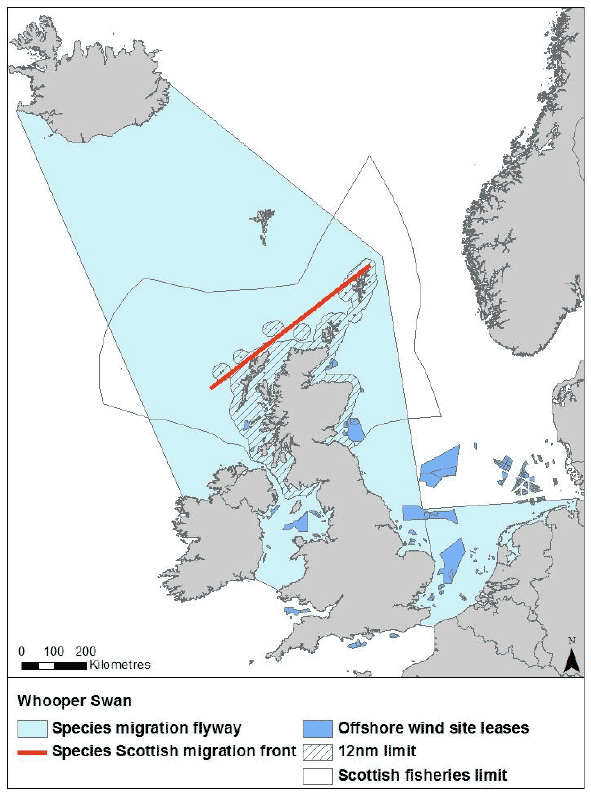
3.45. Though it is a rare breeding species, Scotland's 8-12 pairs represent the total British breeding population (Musgrove et al. 2013). Autumn migration from their breeding grounds takes place from mid September to November with peak numbers occurring in Scotland during early winter before a shift in distribution with birds moving into England and Ireland (Wernham et al. 2002, Griffin et al. 2010). During the last two Icelandic whooper swan Censuses (2005 and 2010) 4,331 and 2,659 individuals were counted in Scotland equating to 16% and 10% of the Icelandic population of 26,500 birds (Hall et al. 2012, Wetlands International 2012). The 2010 winter was especially cold so more birds may have wintered in England that may otherwise have wintered in Scotland. To take account of this the mean of the last two Icelandic whooper Swan Census counts was used to produce a Scottish wintering estimate of 3,495 birds. Satellite tracking has confirmed that movement of birds between sites and their departure to/arrival from breeding sites around Iceland produces quite a wide migration front (Griffin et al. 2010). In determining numbers passing through Scottish waters on migration, two thirds of the Irish wintering population of 15,068 (Hall et al. 2012) were added to the GB population of 11,859 (Hall et al. 2012) based on satellite telemetry data (Griffin et al. 2010) to yield an estimate of 22,000 or 83% of the Icelandic population passing through Scottish waters on Autumn and Spring migration. From satellite tracking data (Griffin et al. 2010) and resightings data (Wernham et al. 2002) 70% of swans were assumed to fly along the west coast and 30% along the east coast. Fifty percent of whooper swans are estimated to fly at collision risk height (Wright et al. 2012).
Taiga bean goose Anser fabalis fabalis
Figure 6 - Migration flyway of Taiga bean goose passing Scottish waters
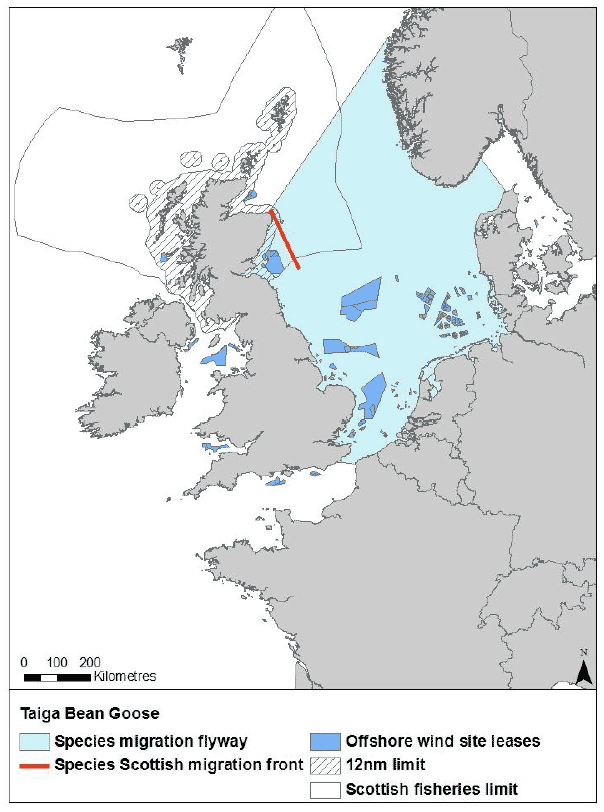
3.46. No Taiga bean geese breed in Scotland but roughly 250 birds over winter on the Slamannan plateau near Falkirk and 10-100 individuals are seen on passage each year (Forrester et al. 2007). Summing the overwintering and 100 passage birds produces an estimate of 350 birds potentially passing Scottish waters on migration in autumn and spring.
3.47. In 2013 six geese were caught on the Slamannan plateau and fitted with GPS tags by the Wildfowl & Wetlands Trust as part of an Scottish Natural Heritage funded project. The four tags transmitting 'live' data revealed different routes on their spring migration suggesting a potentially broad front across Scotland to Denmark then on to Norway and breeding grounds in Sweden (see http://scotlandsbeangeese.wikispaces.com). Though important in solving where these birds bred, in terms of the migration front used it represents a small sample size on only one migration so the flyway map above incorporates some uncertainty. It is hoped that the remaining two radio- GPS transmitter tags which are storing data through the summer and autumn migration will provide further information when they are recovered. Thirty percent of Taiga bean geese are estimated to fly at collision risk height (Wright et al. 2012). The flyway population size is 40,000 to 45,000 (Wetlands International 2012).
Pink-footed goose Anser brachyrhynchus
Figure 7 - Migration flyway of pink-footed goose passing Scottish waters
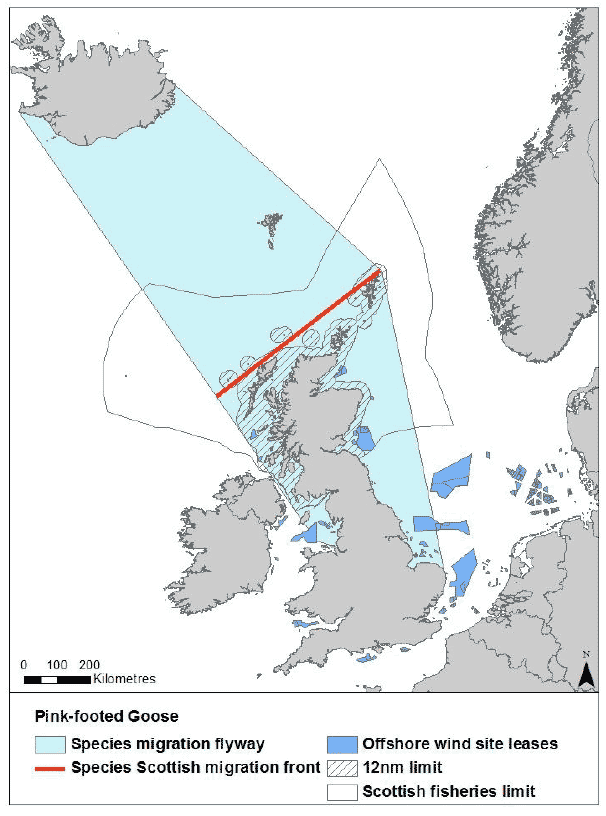
3.48. The entire Greenland and Iceland breeding pink-footed goose populations winter in Great Britain and migrate across Scottish waters. Birds arrive in Scotland from early September and considerable redistribution across Britain occurs during the winter (Wright et al. 2012). Given such turnover assessing the number wintering in Scotland is problematic, though Scottish mid-winter counts are of the order of 100,000 - 150,000 birds (Forester et al. 2007) with 135,614 counted in November and 117,963 in December during the 2011 Icelandic Breeding Goose Census (Mitchell 2012). The entire Great Britain wintering population which passes through Scotland on autumn and spring migration is estimated at 360,000 birds (Musgrove et al. 2013). Diurnal movements from roosting to feeding sites may be important at some offshore wind farm locations (Wright et al. 2012). Birds in southern Britain start to move north in February leading to increasing proportions in Scotland and almost the entire population here in March and April. Return migration to Iceland begins around mid-April. From resightings data (Wernham et al. 2002) and the distribution of wintering sites (Forester et al. 2007) 70% of geese were assumed to fly along the east coast and 30% along the west coast. Thirty percent of birds are estimated to fly at collision risk height (Wright et al. 2012).
Greenland white-fronted goose Anser albifrons
Figure 8 - Migration flyway of Greenland white-fronted goose passing Scottish waters
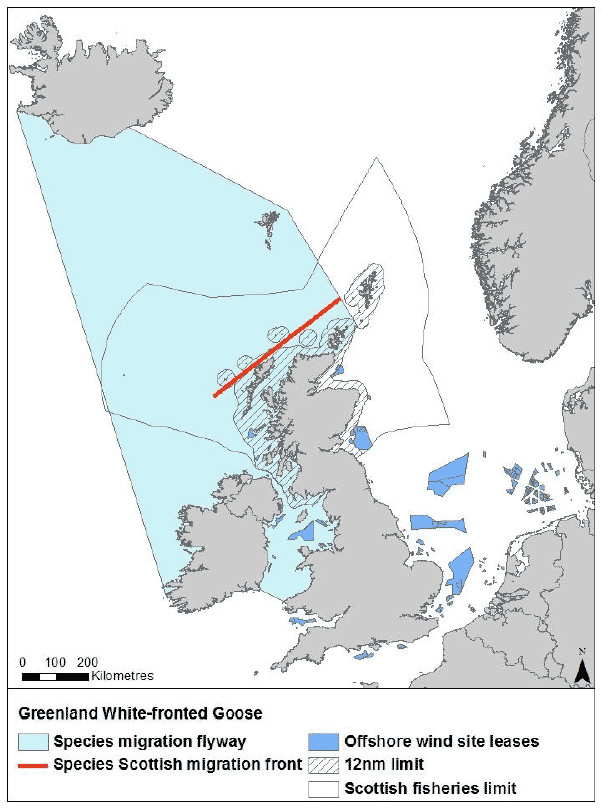
3.49. With the exception of very few records in England and Wales, all of the 13,000 Greenland white-fronted geese wintering in Great Britain winter in Scotland (Musgrove et al. 2013, Fox et al. 2012). This represents 54% of this subspecies population of 24,000 birds (Wetlands International 2012),. Between 40% and 60% of Scottish wintering birds are counted on Islay with other major areas including South Argyll and Lochaber/North Argyll (Fox et al. 2012). Given this bias in distribution it is assumed for modelling that a higher proportion of birds (90%) potentially pass down the west coast of Scotland. Colour marking studies have shown some within winter interchange with Irish wintering sites. Warren et al. (1992) showed on average 2.8% of birds wintering at Wexford Slobs moved to or from Scotland within a winter. However, from a Scottish perspective it is perhaps more useful to consider collision risk with regard to the Great Britain wintering population rather than include an additional potentially unreliable percentage from the Irish wintering population. Thirty per cent of birds are estimated to fly at collision risk height (Wright et al. 2012). It should be noted for specific project risk assessments that, especially in the spring migration departures may be very concentrated from the key sites.
Icelandic greylag goose Anser anser
Figure 9 - Migration flyway of Icelandic greylag goose passing Scottish waters
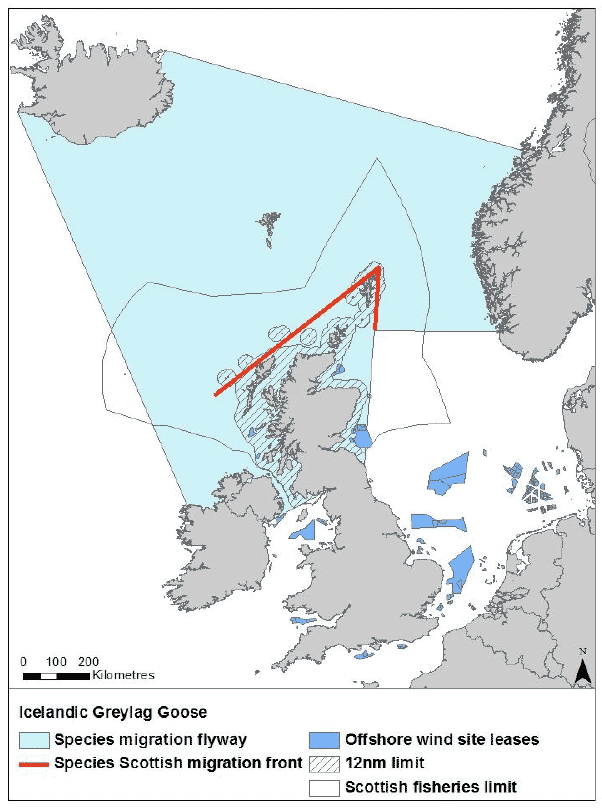
3.50. Icelandic breeding greylag geese winter almost exclusively in Scotland. Estimating the numbers of Icelandic greylag geese wintering here is complicated by an increasing population of Scottish breeding birds being present in their wintering areas. Correcting counts from the Icelandic Breeding Goose Census in 2011/12 by late summer counts of Scottish breeding birds, WWT estimated 111,558 wintering Icelandic greylag geese in Scotland ( http://monitoring.wwt.org.uk/wp-content/uploads/2013/09/IGC_2012report.pdf). Note that this estimate, which may be reviewed. is 36% higher than the previous estimate of 85,000 (Musgrove et al. 2013) but reflects the generally increasing population trend since the early 2000's. They winter predominantly in Orkney and Caithness, around the Moray Firth, in Aberdeenshire and in east-central Scotland with smaller numbers in southwest and southeast Scotland. As winter progresses a general movement south and considerable re-distribution was traditionally reported, but this now rarely happens and the population has contracted northwards, especially to Orkney ( http://monitoring.wwt.org.uk/wp-content/uploads/2013/09/IGC_2012report.pdf). In the 2011/12 winter 56% of birds were counted on Orkney and most of their other wintering sites are in the east of Scotland (Mitchell 2012). For modelling it was thus assumed that 50% of geese pass no further south than Orkney, and from the distribution of wintering sites (Forester et al. 2007) 40% of geese were assumed to fly along the east coast and 10% along the west coast. Thirty per cent of birds are estimated to fly at collision risk height (Wright et al. 2012). Given the present trend for the wintering distribution to contract northwards, for the present locations of offshore wind farms the concentration on Orkney are unlikely to be at risk, but any future proposals nearer or to the north of here should take account of a potentially high concentration of migrants. The latest official biogeographic flyway population is estimated at 87,200 birds (Wetlands International 2012). The migration flyway for this species has been adjusted from that presented in the SOSS-05 report after correspondence with WWT's species conservation department.
Greenland barnacle goose Branta leucopsis
Figure 10 - Migration flyway of Greenland barnacle goose passing Scottish waters
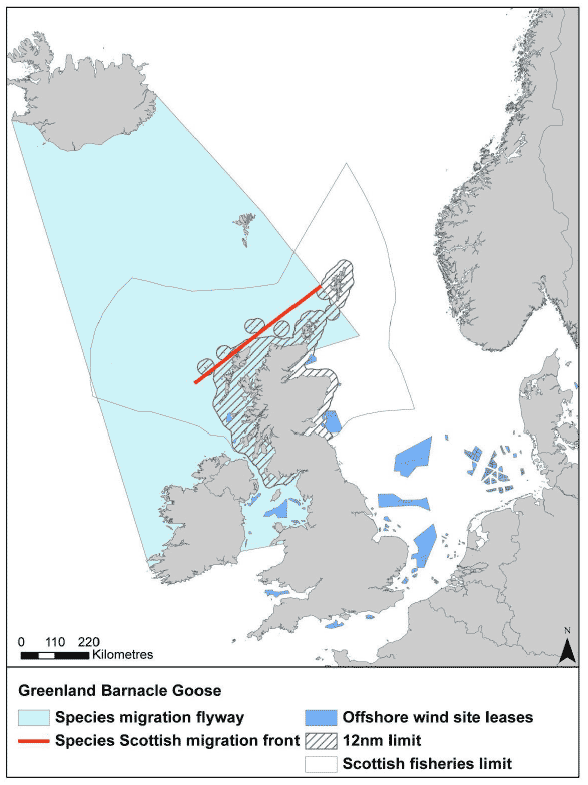
3.51. The winter range of the Greenland population is confined to islands and mainland sites along the north and west coasts of Scotland and Ireland. Their range in Scotland extends throughout the Inner and Outer Hebrides and north to Orkney. Due to the inaccessibility of many of the wintering sites, aerial surveys, which are undertaken roughly every five years, are required to census this species. The last census undertaken in 2008 recorded 58,269 geese in Scotland, which was rounded to 58,000 for the population estimate (Mitchell et al. 2008, Musgrove et al. 2013). Of these, 44,961 or 77%, were counted on Islay. Based on the locations of wintering sites it was assumed that no birds crossed east coast Scottish waters. Thirty per cent of birds are estimated to fly at collision risk height (Wright et al. 2012). It should be noted for specific risk assessments that projects around Islay may have a proportionally greater effect on the wintering population than projects in other areas. The biogeographic winter flyway population is estimated at 70,000 birds (Wetlands International 2012). The species migration flyway for this species has been adjusted from that presented in the SOSS-05 report after correspondence with WWT's species conservation department.
Svalbard barnacle goose Branta leucopsis
Figure 11 - Migration flyway of Svalbard barnacle goose passing Scottish waters
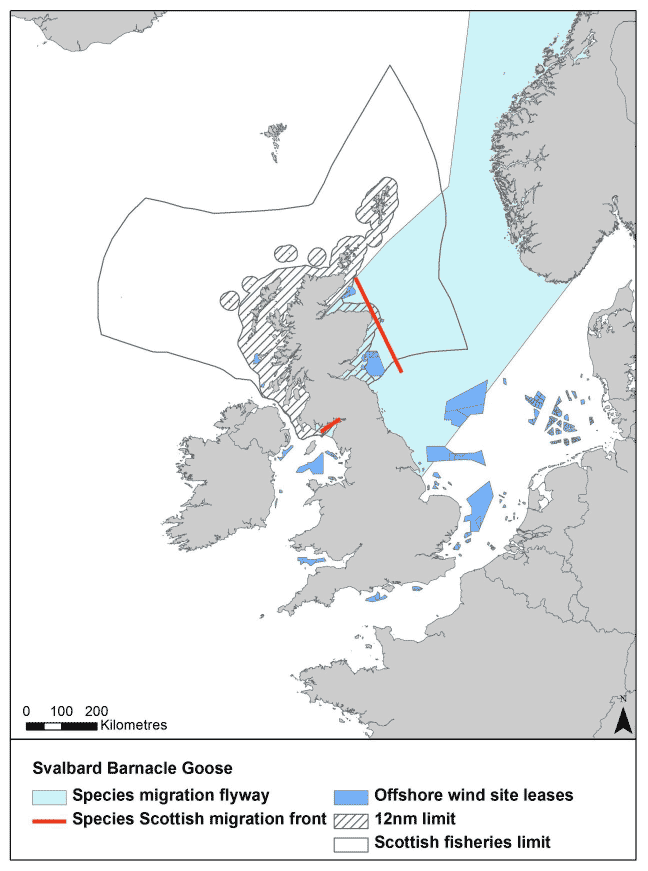
3.52. The Svalbard breeding population of 30,000 barnacle geese (Wetlands International 2012) winters almost exclusively around the Solway Firth. Satellite tracking has shown that migration is normally via staging grounds in Norway to/from eastern Scotland and ultimately the Solway, but some birds can make the journey direct in some 36 hours (Griffin 2008). The restricted wintering range on the Solway extends from Mersehead in the west to Cummertrees in the east in Dumfries and Galloway and to Rockcliffe and Newton Marshes on the Cumbrian coast, with the latest wintering estimate of 33,000 birds (Musgrove et al. 2013). Satellite tracking of 26 birds has shown that they tend to move along the Solway coastline, crossing the Solway where it narrows towards Cummertrees and Skinburness (Griffin et al. 2011). For this study and following the conclusions of Griffin et al. (2011) it was assumed that there was no risk to geese from current wind farm projects in the Solway now that the Wigtown Bay site has been withdrawn. However it should be noted that more inshore areas of the Solway are especially sensitive for this species as they support effectively the entire wintering population and the relatively few geese that were satellite tracked may not be wholly representative of movements of the entire population either now or in the future. Thirty per cent of birds are estimated to fly at collision risk height (Wright et al. 2012). The species migration flyway for this species has been adjusted after correspondence with WWT's species conservation department.
Canadian light-bellied brent goose Branta bernicla hrota
Figure 12 - Migration flyway of Canadian light-bellied brent goose passing Scottish waters
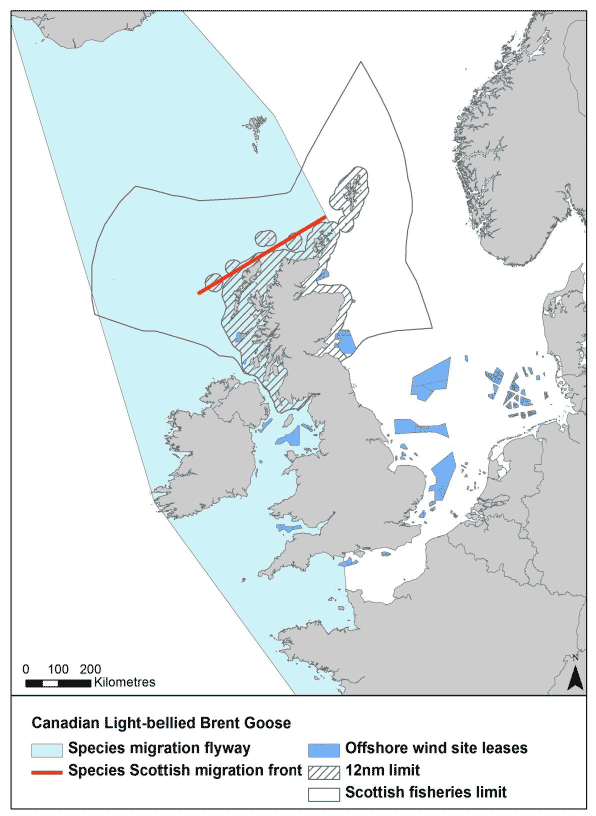
3.53. Almost all of the 40,000 east Canadian breeding light-bellied brent geese (Wetlands International 2012) winter in Ireland with much smaller numbers reaching the west coast of Great Britain and the north coasts of France and Spain. Strangford Lough in Northern Ireland is the most important site hosting over 75% of the population ( WWT 2013). In Scotland they are regular on passage through the Inner and Outer Hebrides in September and October and again in April and May with turnover through a single locality perhaps totalling as much as 1,000 - 2,000 birds in the autumn (Forester et al. 2007). Satellite tracking has confirmed that birds wintering in Ireland pass along the Scottish north and east coast particularly on autumn migration (Griffin et al. 2012). Summing monthly counts between 1996 and 2001 suggests around 600 birds may be recorded on passage in spring (March to May) and 1,300 in autumn (August to November) (Forrester et al. 2007). It should be noted that this could potentially be a considerable underestimate as birds flying through Scottish waters or stopping only briefly en-route to Ireland will be missed from these counts - two out of three birds fitted with satellite tags passed through Scottish waters en-route to Ireland on Autumn migration (Griffin et al. 2012), but this is a very small sample size. Very few birds are counted wintering - the five-year mid-winter mean from WeBS counts at Scottish sites between 2006/07 and 2010/11 was 126 (Holt et al. 2012). Thirty per cent of birds are estimated to fly at collision risk height (Wright et al. 2012). The species migration flyway for this species has been adjusted after correspondence with WWT's species conservation department.
Svalbard light-bellied brent goose Branta bernicla hrota
Figure 13 - Migration flyway of Svalbard light-bellied brent goose passing Scottish waters
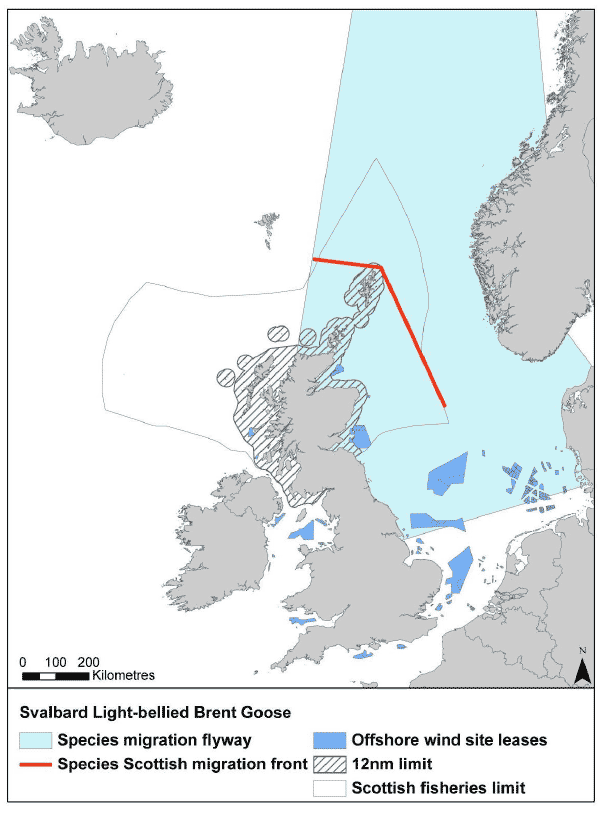
3.54. This is a scarce migrant and uncommon winter visitor to Scotland with 60-150 wintering birds (Forrester et al. 2007). The vast majority of the Great Britain wintering population of 3,400 winter at Lindisfarne, Northumberland (Musgrove et al. 2013) and the remaining birds of the 7,600 flyway population winter in Denmark (Wetlands International 2012). The five-year mid-winter mean from WeBS counts at Scottish sites between 2006/07 and 2010/11 was 94 (Holt et al. 2012). Birds thought to be from Svalbard appear on the east coast in September and October, usually seen on estuaries such as Fife Ness, Tentsmuir Point or St Abb's Head in small flocks of up to 50 birds. Very few birds are viewed on return passage (Forrester et al. 2007). Summing monthly counts between 1996 and 2001 suggests around 50 birds may be recorded on passage in spring (March to May) and 300 in autumn (August to November) (Forrester et al. 2007). Thirty per cent of birds are estimated to fly at collision risk height (Wright et al. 2012). The species migration flyway for this species has been adjusted after correspondence with WWT's species conservation department.
Shelduck Tadorna tadorna
3.55. About 1,750 pairs of shelduck breed in Scotland from March to July (Forrester et al. 2007). In winter the population swells to 7,000 with birds arriving from Fennoscandia, Germany and England (Forrester et al. 2007). Shelduck breeding in Britain do not migrate to a wintering area but most participate in a moult migration to the Helgoland Bight of the Wadden Sea (Wernham et al. 2002). North West European wintering populations are estimated at 300,000 (Wetlands International, 2012). Due to a lack of data on numbers in Scotland during spring and autumn passage this species has not been included in collision risk modelling.
Wigeon Anas penelope
Figure 14 - Migration flyway of wigeon passing through Scottish waters
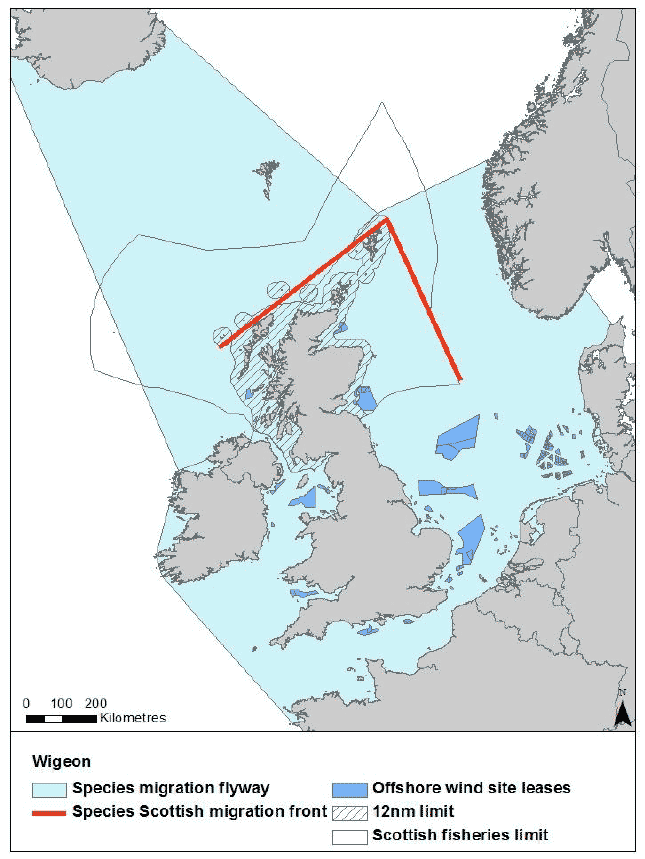
3.56. Scotland has 240-400 breeding pairs of wigeon and 76,000-96,000 individuals in winter (Forrester et al. 2007). Wigeon winter in Scotland from September to April originating in Iceland, Fennoscandia and Russia. Sites associated with the Moray Firth have the greatest concentrations in winter and hold nationally important numbers (Forrester et al. 2007). Biogeographic population estimates are 300-500 pairs breeding in the UK and 1,500,000 birds wintering in North West Europe (Wetlands International 2012). The number of birds passing through Scottish waters has not previously been estimated in the literature, therefore an approach was agreed with Scottish Natural Heritage so that the species could be modelled. The geographical proportion of the UK flyway taken up by Scotland was measured and this proportion was applied to the UK wintering population of 450,000 (Musgrove et al. 2013). Additionally all wigeon breeding in Iceland were assumed to pass through Scottish waters. This gives an estimated passage population of 214,000. Approximately 15% are estimated to fly at collision risk height (Wright et al. 2012).
Teal Anas crecca
Figure 15 - Migration flyway of teal passing through Scottish waters
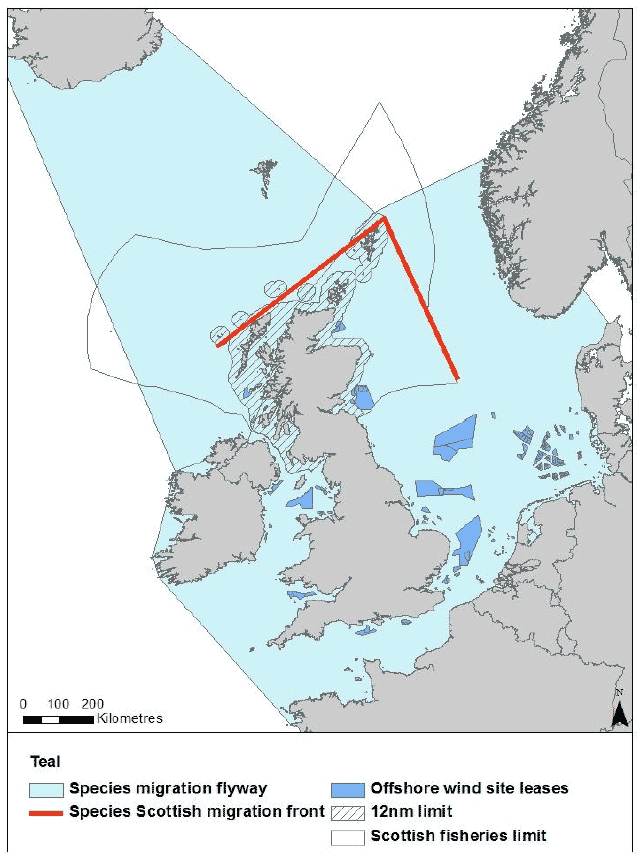
3.57. Scotland has 1,950-3,400 breeding pairs of teal (60% of the UK breeding population) and an estimated 37,500 individuals in winter, although there can occasionally be as many as 125,000 (Forrester et al. 2007). Teal winter from October-April and arrive from Iceland, Fennoscandia and Russia (Forrester et al. 2007). Winter numbers from North West Europe are estimated at 500,000 birds (Wetlands International 2012). The number of birds passing through Scottish waters has not previously been estimated in the literature, therefore an approach was agreed with Scottish Natural Heritage so that the species could be modelled. The geographical proportion of the UK flyway taken up by Scotland was measured and this proportion was applied to the UK wintering population of 220,000 (Musgrove et al. 2013), giving an estimated passage population of 100,000. Approximately 15% are estimated to fly at collision risk height (Wright et al. 2012).
Mallard Anas platyrhynchos
3.58. In Scotland 17,000-43,000 pairs of mallard breed from February to September (Forrester et al. 2007). From mid September onwards the Scottish mallard population swells to 65,000-90,000 by autumn immigrants arriving from Ireland and Fennoscandia, with some from further east (Wernham et al. 2002). Main winter locations are large estuaries particularly the Moray Firth including Loch Fleet, Sutherland and the Dornoch, Cromarty, Beauly and Inverness Firths, the Firth of Tay, the inner Firth of Forth, the inner Firth of Clyde and the Solway Firth and associated bays (Forrester et al. 2007). Once at their wintering site they are relatively sedentary as winter progresses (Wernham et al. 2002). The North West European population is thought to be around 4,500,000 birds (Wetlands International 2012). Due to a lack of data on numbers in Scotland during spring and autumn passage this species has not been included in collision risk modelling.
Pintail Anas acuta
Figure 16 - Migration flyway of pintail passing Scottish waters
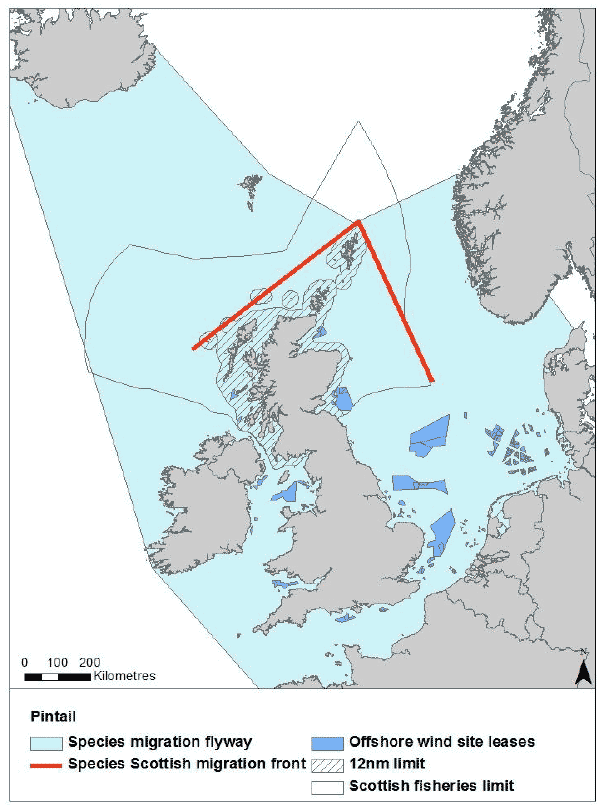
3.59. Scotland supports 20-30 breeding pairs of pintail which 60% of the British breeding population. In winter between September and April 4,000-4,500 birds arrive in Scotland from Iceland and continental Europe (Forrester et al. 2007). Pintail are highly localised winter visitors and significant concentrations occur in a small number of estuarine and lowland loch sites in the south west and north-east mainland (Wernham et al. 2002). The number of wintering individuals estimated for North West Europe is 60,000 birds (Wetlands International 2012). Approximately 15% are estimated to fly at collision risk height (Wright et al. 2012).
Shoveler Anas clypeata
3.60. In Scotland 260-390 pairs of shoveler breed from April to August (Forrester et al. 2007). From September to January 400 to 750 birds winter in Scotland. Highest numbers of shoveler occur during autumn passage where birds migrate south to England, Ireland, France and the Iberian Peninsula (Forrester et al. 2007). Biogeographic population estimates are 1,000 to 1,500 pairs breeding in the UK (Baker et al. 2006) and 40,000 wintering birds in North West and central Europe (Wetlands International 2012). The species migration flyway for this species has been adjusted after correspondence with WWT's species conservation department. Due to a lack of data on numbers in Scotland during spring and autumn passage this species has not been included in collision risk modelling.
Pochard Aythya farina
Figure 17 - Migration flyway of pochard passing Scottish waters
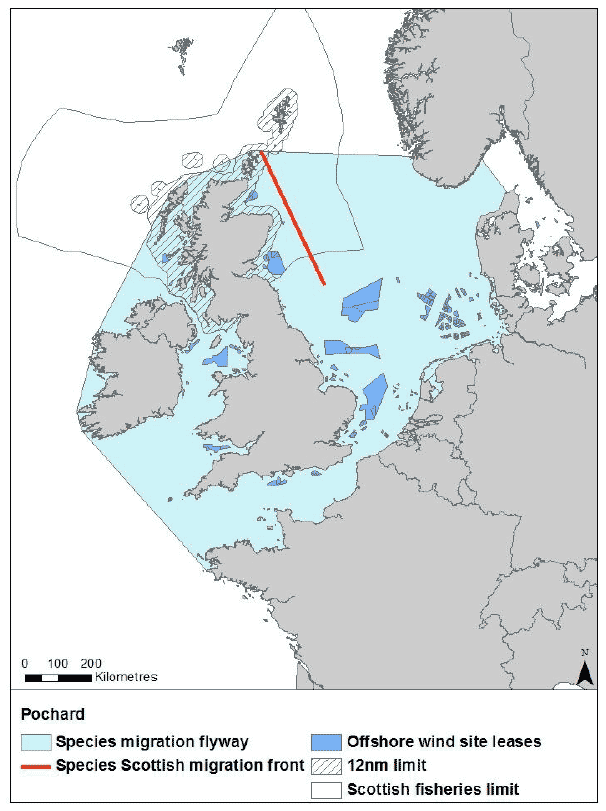
3.61. Pochard have a small breeding population of only 25-50 pairs in Scotland (Forrester et al.2007). They are widespread on passage and in winter with high concentrations in the east central lowlands, the north-east and Orkney. Most of the Scottish non breeding pochard are thought to come from the Baltic States with the Icelandic population also moving through Scotland outside of the breeding season (Forrester et al. 2007). North East and North West Europe contain 350,000 birds in the winter (Wetlands International 2012). Fifteen percent are thought to fly at collision risk height (Wright et al. 2012).
Tufted duck Aythya fuligula
Figure 18 - Migration flyway of tufted duck passing Scottish waters
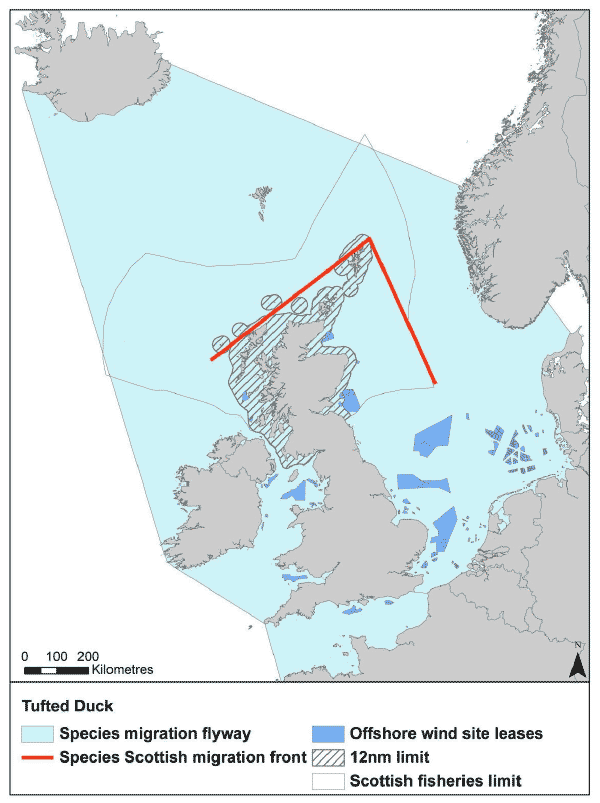
3.62. Tufted duck is widespread and locally common as a Scottish breeder with 2,250-2,700 pairs (Forrester et al. 2007). Approximately 11,000 birds winter in Scotland when breeders move south and west and are replaced by migrants from Iceland, Fennoscandia and Russia (Forrester et al. 2007). Approximately 1,200,000 birds winter in Western Europe (Wetlands International 2012). Fifteen percent are thought to fly at collision risk height (Wright et al. 2012).
3.63. Scaup Aythya marila
Figure 19 - Migration flyway of scaup passing Scottish waters
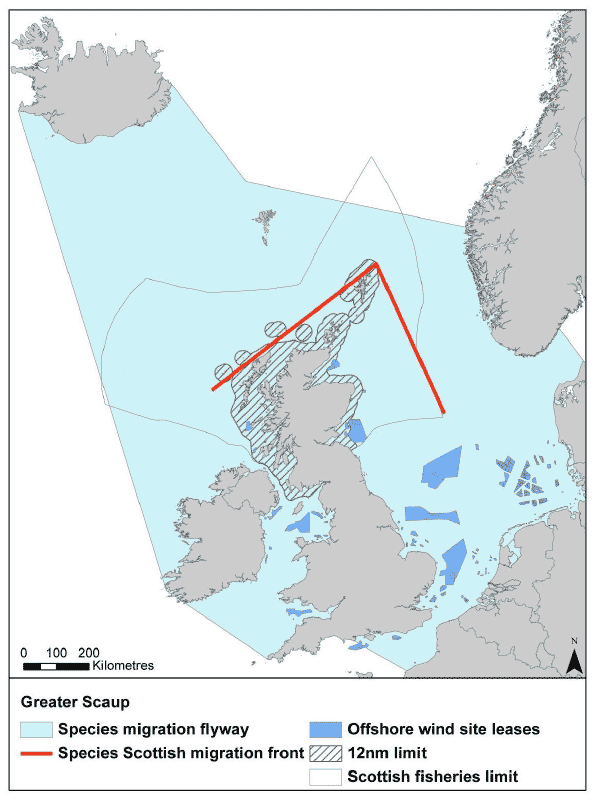
3.64. Scaup are almost exclusively a winter visitor to Scotland with very few breeding records. The winter population is estimated at 4,000-8,000 individuals (Forrester et al. 2007). Spring passage occurs from March to April and autumn passage from September to November with the majority of birds coming from Iceland but there are also influxes from Finland and Russia (Wernham et al. 2002). Approximately 310,000 birds winter in Western Europe (Wetlands International 2012). The species migration flyway for this species has been adjusted after correspondence with WWT's species conservation department. Fifteen percent are estimated to fly at collision risk height (Wright et al. 2012).
Eider Somateria mollissima
3.65. Scotland is known to support a breeding population of 20,000 females (Forrester et al. 2007). The main breeding concentration occurs in Eastern areas, particularly the Firth of Forth and the Firth of Clyde. Birds re-occupy nest sites in April, first ducklings are usually recorded in early May and breeding season extends until August. Scotland hosts a wintering population of 64,500 birds (Forrester et al. 2007), based on this estimate Scotland contains 75-80% of British and Irish breeding populations. This includes local breeders from Scotland, smaller numbers from Wadden Sea, Baltic, Denmark and the Netherlands. The biogeographic population estimate is 73,000 wintering individuals in Britain and Ireland (Wetlands International 2012). Due to a lack of data on numbers in Scotland during spring and autumn passage this species has not been included in collision risk modelling.
Long-tailed duck Clangula hyemalis
Figure 20 - Migration flyway of long-tailed duck passing Scottish waters
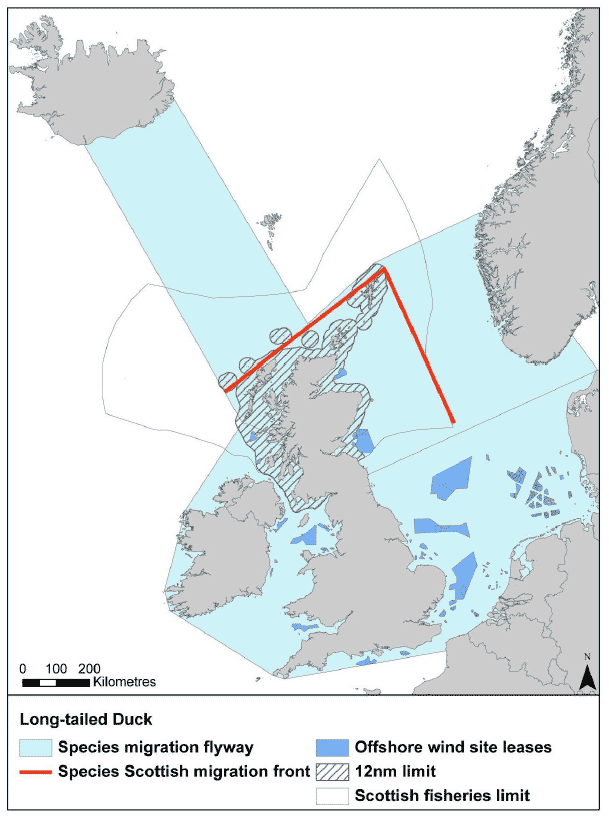
3.66. Long-tailed duck do not breed in Scotland but it is a fairly common winter visitor with about 15,000 individuals using the Scottish coast as a wintering ground between October and February. This includes breeders from Iceland and Fennoscandia (Forrester et al. 2007). Spring passage occurs in March-April with around 15,000 birds passing through Scottish waters. Autumn migration occurs in September - October with around 20,000 birds passing through Scottish waters including individuals coming from Iceland and Fennoscandia. Biogeographic population estimates are 4,600,000 wintering individuals in West Siberia and Northern Europe (Wetlands International 2012). The species migration flyway for this species has been adjusted after correspondence with WWT's species conservation department. Fifteen percent are estimated to fly at collision risk height (Wright et al. 2012).
Common scoter Melanitta nigra
Figure 21 - Migration flyway of common scoter passing Scottish waters
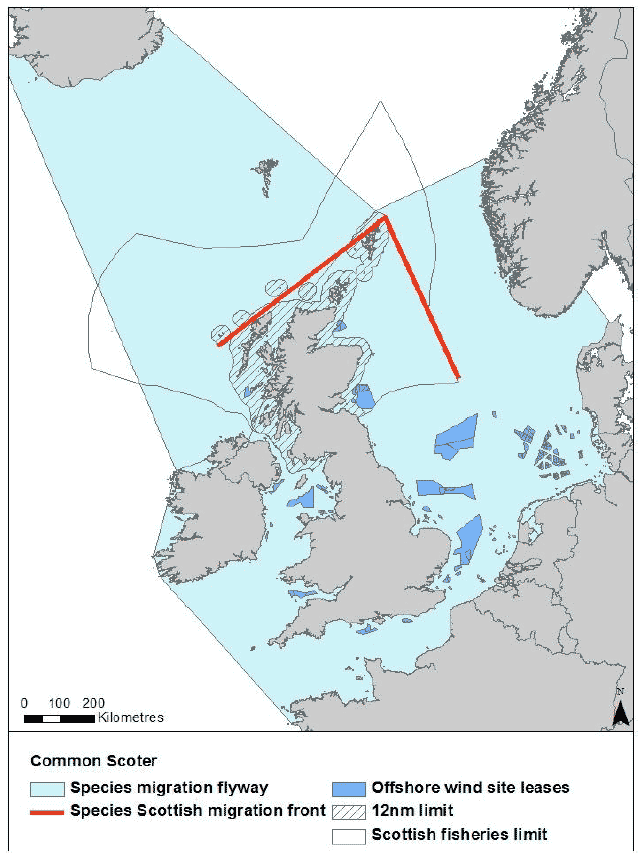
3.67. About 95 pairs of common scoter breed in Scotland (Forrester et al. 2007). Birds re-occupy nests in April and can be attending the colony until September. Scotland has a winter population of 25,000-30,000 birds, although there is a great variation between individual sites. Up to 100,000 birds have been recorded in Liverpool Bay and Carmarthen Bay in the last few years (Cranswick in Forrester et al. 2007). Individuals come from breeding populations in Fennoscandia, Iceland and Finland. Spring migration happens in April, with individuals from Scotland and other UK locations. Autumn passage takes place in July-August with flocks made of individuals travelling from the breeding grounds in Fennoscandia, Iceland and Finland. The biogeographic population estimate is 1,600,000 wintering individuals (Wetlands International 2012). The number of birds passing through Scottish waters has not previously been estimated in the literature, therefore an approach was agreed with Scottish Natural Heritage so that the species could be modelled. It was assumed that as well as the Scottish wintering population all common scoter wintering off the English, Welsh and Irish coasts may also pass through Scotland on migration, totalling 100,000 birds (Musgrove et al. 2013). Approximately 1% are estimated to fly at collision risk height (Wright et al. 2012 and Cook et al. 2012).
Velvet scoter Melanitta fusca
Figure 22 - Migration flyway of velvet scoter passing Scottish waters
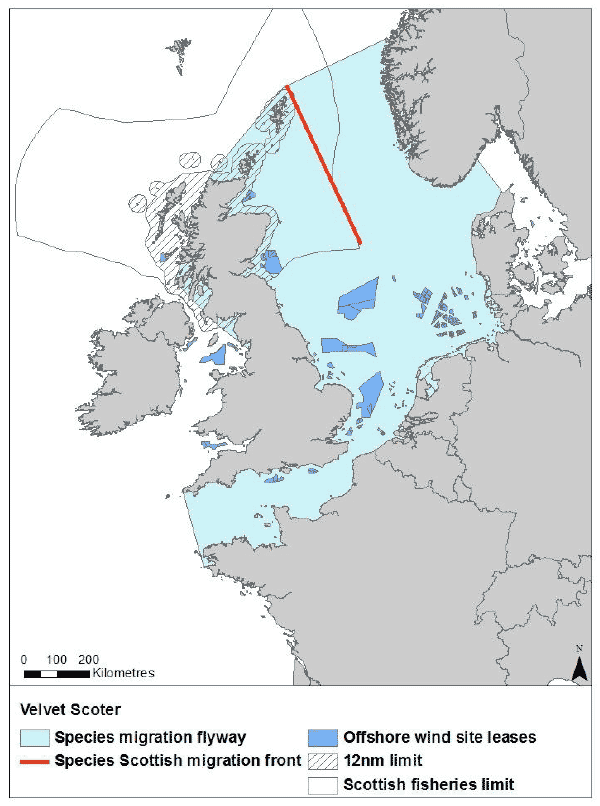
3.68. No velvet scoter breed in Scotland (Forrester et al. 2007). The wintering population is estimated to be about 2,500-3,500 individuals, the largest wintering flocks are recorded on the east coast between September and April and include breeders from Fennoscandia. About 1,000 individuals from Scotland and England pass through the area in February-April and approximately the same number can be recorded during autumn passage, these flocks are made of individuals from breeding populations from Fennoscandia. Biogeographic population estimates are 1,000,000 wintering individuals (Wetlands International 2012). Approximately 15% are estimated to fly at collision risk height (Wright et al. 2012).
Goldeneye Bucephala clangula
3.69. About 150 pairs of goldeneye breed in Scotland (Forrester et al. 2007). Birds re-occupy nests in March and can be attending the colony until July. Between 10,000 and 12,000 individuals are known to winter in Scottish grounds between November and February, most of them from breeding populations in Norway, but also from Sweden, Finland and northern Europe. Spring passage takes place between February and April. Breeders from Northern Europe depart for their breeding grounds in October. Biogeographic population estimates are 1,000,000 - 1,300,000 wintering individuals in Northwest and Central Europe (Wetlands International 2012). Due to a lack of data on numbers in Scotland during spring and autumn passage this species has not been included in collision risk modelling.
Red-breasted merganser Mergus serrator
3.70. About 2,000 pairs of red-breasted merganser breed in Scotland (Forrester et al. 2007). Birds re-occupy nests in April, and can be attending the colony until August. The wintering population in Scotland is estimated in 8,500 individuals and the first birds arrive in the coast of Scotland in early October, most of them are breeders from Iceland (the majority) and Fennoscandia. Biogeographic population estimates are 170,000 wintering individuals in Northwest and Central Europe (Wetlands International 2012). The species migration flyway for this species has been adjusted after correspondence with WWT's species conservation department. Due to a lack of data on numbers in Scotland during spring and autumn passage this species has not been included in collision risk modelling.
Goosander Mergus merganser
3.71. Scotland was probably colonised by goosander from Scandinavia, and 2,000-3,000 pairs breed in Scotland between February and August. First migrants return to Scotland in late October through December from populations from Scandinavia and remain in their wintering grounds until March. It is estimated that between 2,600 and 12,000 birds remain in Scotland during the winter. Spring passage takes place in May and June and is comprised mainly by local breeders. Return autumn migration takes place between June and October, where birds head to their breeding grounds in Scandinavia (Forrester et al. 2007). Biogeographic population estimates are 266,000 wintering individuals in Northwest and Central Europe (Wetlands International 2012). Due to a lack of data on numbers in Scotland during spring and autumn passage this species has not been included in collision risk modelling.
Grey heron Ardea cinerea
3.72. Grey heron is a widely distributed resident breeder in Scotland, with a breeding population of about 3,300-5,230 between February and September. Scandinavian breeders use Scotland as a wintering ground between September and March, and the total wintering population in Scotland is of about 10,000-15,000 individuals, but there's no substantial evidence of local breeders migrating (Forrester et al. 2007). Biogeographic population estimates are 210,000-290,000 breeding pairs in Europe and about 86,000 wintering individuals (Birdlife International 2004). Due to a lack of data on numbers in Scotland during spring and autumn passage this species has not been included in collision risk modelling.
Great crested grebe Podiceps cristatus
3.73. About 240-365 pairs of great crested grebes breed in Scotland. Birds usually arrive in their breeding sites in late February and remain until July. Wintering population in Scotland is comprised of local breeders and individuals from the rest of the UK and Ireland, and numbers range between 900 and 1,500 individuals. Movements between wintering and breeding sites occur in February between birds from UK and Scotland populations. Autumn migration takes place in August-September, birds from the UK, Scotland and Ireland return to their wintering grounds (Forrester et al. 2007). The biogeographic population estimate are 290,000 - 420,000 wintering individuals in Northwest Europe (Wetlands International 2012). Due to a lack of data on numbers in Scotland during spring and autumn passage this species has not been included in collision risk modelling.
Red-necked grebe Podiceps grisegena
3.74. There are only two confirmed records of red-necked Grebe breeding in Scotland for the species. Small numbers of birds are present throughout the year and about 50-100 individuals are known to use Scotland as their wintering grounds, mostly found along the east coast between November and March. Autumn migration involves movements from their breeding to their wintering sites, mostly involving breeding populations from Northwest Europe; it normally starts in late July (Forrester et al. 2007). Biogeographic population estimates are 14,058 - 19,917 breeding pairs in Northwest Europe and 42,000 - 60,000 wintering individuals in Northwest Europe (Wetlands International 2012). Due to a lack of data on numbers in Scotland during spring and autumn passage this species has not been included in collision risk modelling.
Slavonian grebe Podiceps auritus
3.75. About 30-80 pairs of Slavonian grebe breed in Scotland. Birds re-occupy nests in April, and can be attending the colony until August. The wintering population is estimated to be 300-500 individuals, but also includes Iceland and Norway breeders wintering in Scotland between August and February. Autumn passage includes movements from birds from the same locations on route to their wintering grounds. Biogeographic population estimates are 1,544-2,254 breeding pairs in Northwest Europe and 4,600 - 6,800 wintering individuals in Northwest Europe (Wetlands International 2012). Due to a lack of data on numbers in Scotland during spring and autumn passage this species has not been included in collision risk modelling.
White-tailed eagle Haliaeetus albicilla
3.76. After a successful reintroduction, there are now 30 breeding pairs of white-tailed eagle in Scotland, mostly on the Inner and Outer Hebrides and on the west coast. The wintering population is estimated in 250 individuals occupying wintering grounds from September to January. There are considerable gaps in knowledge caused by the remoteness of breeding pairs and their sensitivity to nest disturbance (Forrester et al. 2007). Biogeographic population estimates are 5,000-6,600 breeding pairs in Europe (Birdlife International 2004). A very small number of continental birds are occasionally seen as passage birds and winter visitors, therefore, this species has not been included in collision risk modelling.
Marsh harrier Circus aeruginosus
3.77. Eurasian marsh harrier is a scarce migrant and breeding species in Scotland, where it is known to have a breeding population of 3-8 females (Forrester et al. 2007). Numbers of passing birds have been noted in both spring and autumn. Passage starts in mid-March and peaks in early to mid-May, there have been between 10 and 100 individuals recorded, including Scottish birds and also individuals from Southwest Europe and West Africa. Numbers for autumn passage are slightly lower, being about 10-40 individuals recorded between August and October, most probably local breeders (Forrester et al. 2007). Biogeographic population estimate is 93,000 - 140,000 breeding pairs in Europe (Birdlife International 2004). This species has not been included in the collision risk modelling.
Hen harrier Circus cyaneus
Figure 23 - Migration flyway of hen harrier passing Scottish waters
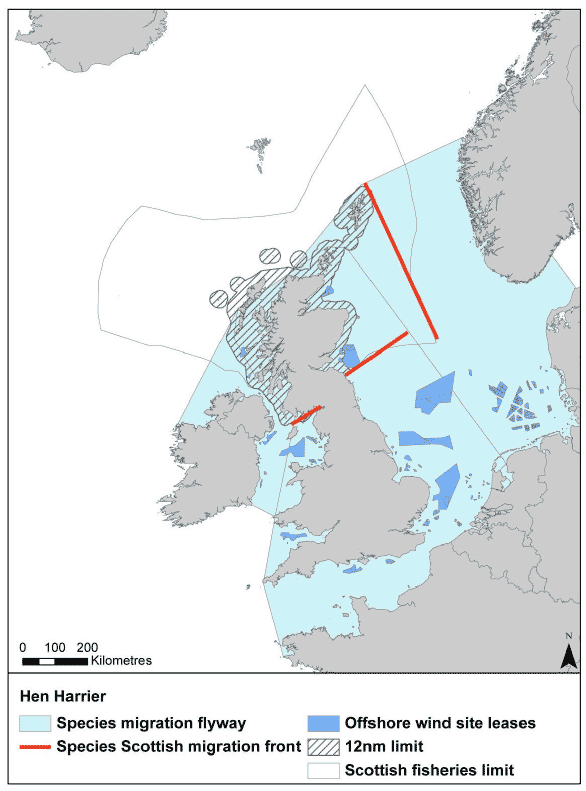
3.78. There are approximately 505 territorial pairs in Scotland (Hayhow et al. 2013). The species breed in mostly upland areas but down to sea-level in parts of western and northern Scotland. The wintering population had been estimated as 1,050-1,540 individuals between August and March in Forrester et al. (2007), most of them from local breeders, but a small arrival of wintering birds from Scandinavia seems possible, although there was no supporting evidence of this. Updating this based on the revised breeding population estimate given in Hayhow et al. (2013) suggests approximately 1,230 individuals (adults and immatures) presently winter in Scotland. Autumn passage takes place from August, when approximately 30% of adults and 40% of immature birds (mostly males) move out of Scotland (Forrester et al. 2007). This equates to some 640 birds on autumn migration. Satellite tracking has shown that most of these birds migrate over the mainland, however a proportion of especially juveniles winter in Ireland, so crossing the Scottish west coast and a proportion of birds from Orkney pass over the Moray Firth and the Firth of Forth. We have assumed for this study, with discussion with RSPB, that 60% of birds migrate solely over the mainland and 20%, or around 130 birds, pass over Scottish west and east coast waters respectively. Spring migration takes place from February to March involving similar numbers to in the autumn. It is estimated that 50% fly at collision risk height (Wright et al. 2012). Biogeographic population estimates are 32,000-59,000 breeding pairs in Europe and about 8,500 individuals wintering in Europe (Birdlife International 2004).
Osprey Pandion haliaetus
Figure 24 - Migration flyway of osprey passing Scottish waters
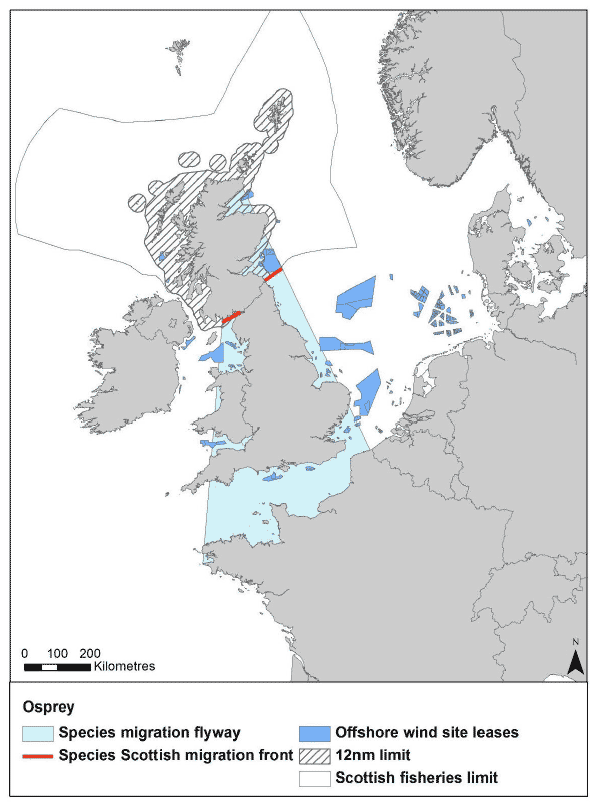
3.79. Approximately 200 pairs breed in Scotland (Forrester et al. 2007). Osprey are long distance migrants, with all birds leaving Scotland from August to September to mainly winter in West Africa, although there is an increasing trend of few individuals wintering in Spain and Portugal. Spring return passage takes place during March and April. There is no regular migration through Scotland of Scandinavian though some birds have been recorded following bad weather (Forrester et al. 2007). Tracking studies suggest maybe 40% of migrating birds may cross eastern coasts especially the Firth of Forth and 25% cross western waters, particularly the Solway Firth (Roy Dennis pers comm.). Based on a productivity of 1.57 young per pair (Forrester et al. 2007) approximately 700 adults and immatures migrate south after breeding with at least 400 returning in the spring to breed. It is estimated that 50% fly at collision risk height (Wright et al. 2012). The biogeographic population estimate is 7,600-11,000 breeding pairs in Europe (Birdlife International 2004).
Sparrowhawk Accipiter nisus
3.80. Around 8,000-12,000 pairs breed in Scotland. The wintering population is estimated to range between 22,000 and 32,000 individuals. There is not enough information on whether any more than trivial numbers of Scandinavian birds overwinter in Scotland. Biogeographic population estimates are 340,000-450,000 breeding pairs in Europe (Birdlife International 2004). Due to a lack of data on numbers in Scotland during spring and autumn passage this species has not been included in collision risk modelling.
Kestrel Falco tinnunculus
Figure 25 - Migration flyway of kestrel passing Scottish waters
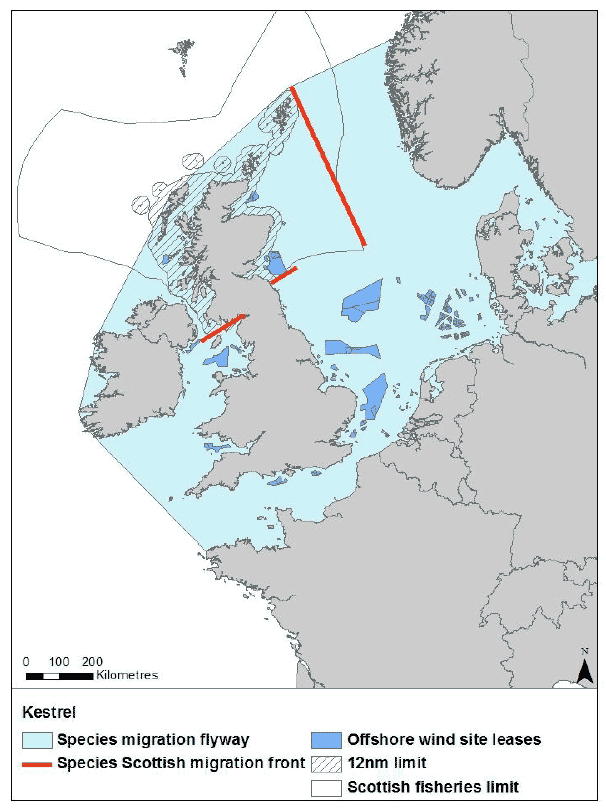
3.81. Kestrel are widespread and common throughout the UK and are found throughout mainland Scotland and some of the Islands. There are 7,500-7,800 breeding pairs in Scotland (Forrester et al 2007) found in a variety of habitats. During winter there is an increase in numbers with migratory birds joining residents from Fennoscandia. It is estimated that winter numbers are between 15,000 and 25,000 (Forrester et al 2007). During both passage periods it is estimated that between 500 and 1,000 individuals pass through or into Scotland. An estimated 50% of kestrels fly at collision risk height (Wright et al. 2012), with most migratory kestrels arriving from the east along a relatively wide migration corridor. The European biogeographic population is 330,000-500,000, the Scottish breeding population is approximately 3% of this.
Merlin Falco columbarius
3.82. Merlin can be found throughout Scotland, in particular across upland moorland areas. There are an estimated 800 pairs of merlin breeding in Scotland and they have a breeding season between March and September (Forrester et al. 2007). During the winter months merlin migrate locally to coastal and inland lowland areas and they are joined by winter migrants from Iceland (Forrester et al 2007). Movements during passage are not well recorded and the percentage flying at collision risk height has not been calculated. Fifty per cent of similar species, such as kestrels, are estimated to fly at collision risk height and this may be a good approximation for merlin. The biogeographic population of merlin is between 31,000 and 49,000 (Birdlife International 2004); the Scottish population is around 3% of this. Due to a lack of data on numbers in Scotland during spring and autumn passage this species has not been included in collision risk modelling.
Corncrake Crex crex
Figure 26 - Migration flyway of corncrake passing Scottish waters
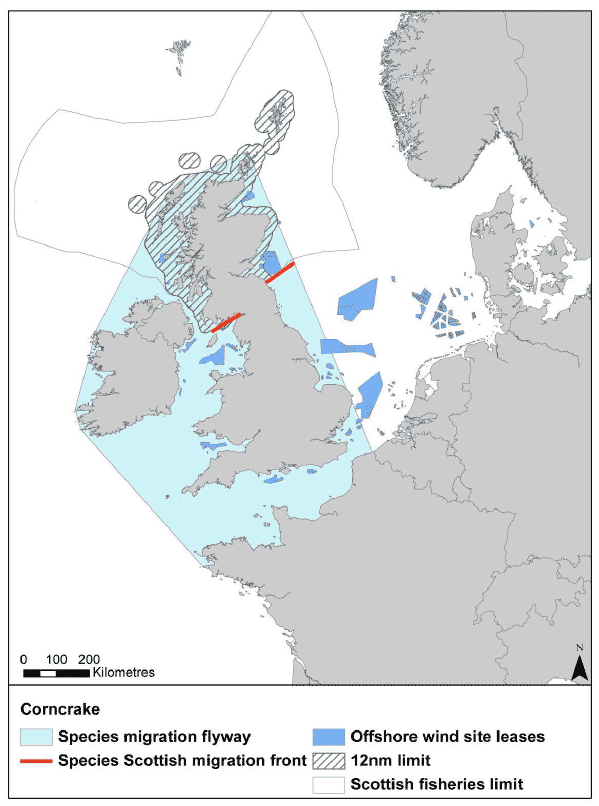
3.83. Ninety nine per cent of the British breeding population breed in Scotland, with on average 1,198 calling males between 2008 and 2012 ( RSPB 2013, pers. comm.). Of these most are in the Western Isles, Orkney and Shetland. They leave their Scottish breeding sites from July to September, with a few records in October and November, and travel to their wintering grounds in Trans-Saharan Africa. On average 6.9 young may fledge the nests (Green, 1999), so the total number migrating in the autumn may be around 10,660. Adults return to the Scottish breeding grounds in late April and early May (Wernham et al. 2002). Approximately 50% are thought to fly at collision risk height (Wright et al. 2012).
Oystercatcher Haematopus ostralegus
Figure 27 - Migration flyway of oystercatcher passing Scottish waters
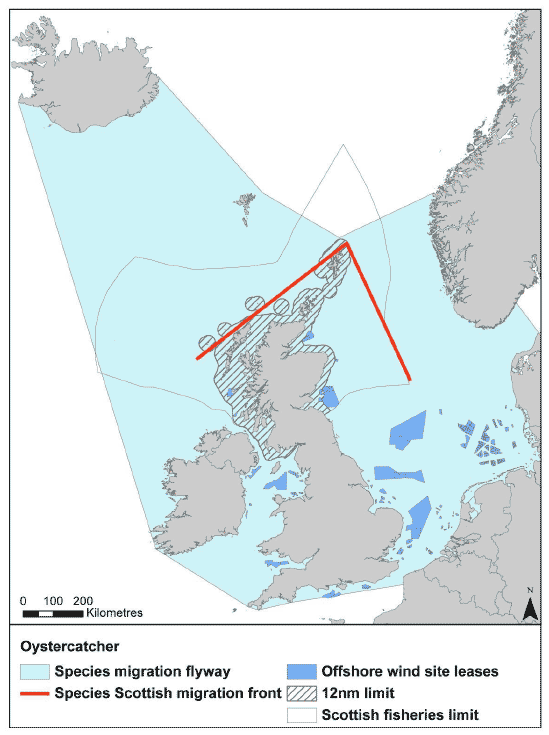
3.84. An estimated 84,500-116,500 pairs of oystercatcher breed in Scotland in any given season constituting 71% of the British breeding population (Forrester et al. 2007). The distinct Atlantic population of the nominate race ostralegus number approximately 200,000 constitute the entire British and Irish breeding and wintering population (Wernham et al. 2002, Hulscher et al. 1996). Migration of birds breeding in Britain is only partial and northern populations, including the Scottish population, tend to travel further than their Southern counterparts, particularly down the West coast of Britain (Wernham et al. 2002). Birds from Scotland will travel mainly down the West coast across the Moray Firth and Firth of Forth where they may encounter offshore wind farms (Wernham et al. 2002). A few may cross the Channel to winter on the French and Iberian coasts. A significant number of birds that have bred elsewhere, particularly the Faroe Isles, Iceland and Norway, will winter in Scotland arriving in August or September (Wernham et al. 2002). Approximately 25% are estimated to fly at collision risk height (Wright et al. 2012).
Ringed plover Charadrius hiaticula
3.85. Ringed plover are residents around the Scottish mainland coast and can also be found throughout the Hebrides and Northern Isles. An estimated 4,900-6,700 pairs breed in Scotland between April and August before winter numbers are increased by migrant species from Iceland, Greenland and Norway to 23,000-25,000 individuals (Forrester et al. 2007). Autumn migration occurs between August and October with spring migrants arriving returning between January and April. The percentage flying at collision risk height has not been calculated for this species but it is reasonable to assume it is similar to other small waders such as dunlin. The wintering biogeographic population for the species is 73,000 (Wetlands International 2012), the number wintering in Scotland could be as much as 33% of this total. Due to a lack of data on numbers in Scotland during spring and autumn passage this species has not been included in collision risk modelling.
Dotterel Charadrius morinellus
Figure 28 - Migration flyway of dotterel passing Scottish waters
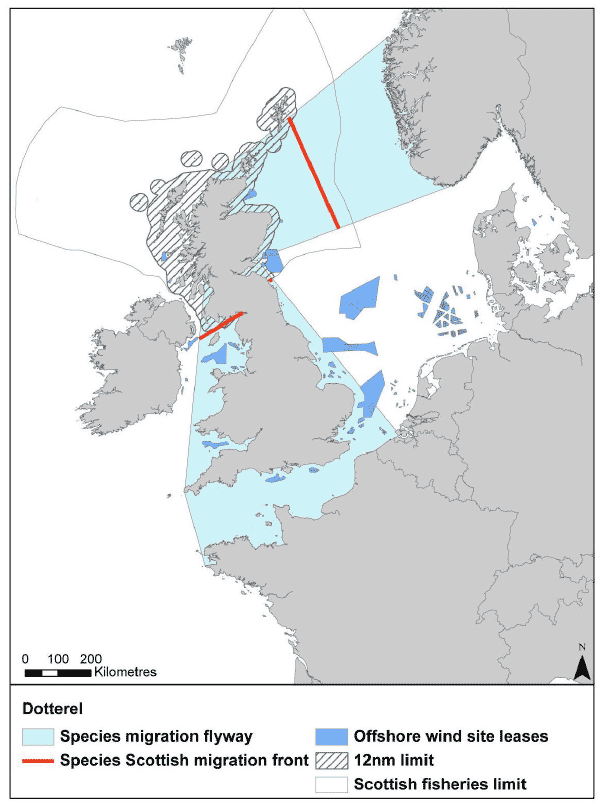
3.86. Dotterel breed in the Eastern Highland of Scotland with an estimated 510-750 males recorded. The breeding season occurs between May and August (Forrester et al. 2007). Dotterels are not wintering birds in Scotland with the majority of birds wintering in N Africa. Numbers of passage migrants are not well recorded though 2,000-3,000 birds are believed to pass through Scotland during the spring (Forrester et al. 2007). Dotterel are found predominantly on the eastern side of Scotland and migrate along a relatively narrow migration corridor (500km). As with other waders it is estimated that 25% of migrating birds fly at collision risk height (Wright et al. 2012). The biogeographic population for dotterel is and estimated 40,000-120,000 birds, the Scottish population is approximately 1% of this estimate.
Golden plover Pluvialis apricaria
Figure 29 - Migration flyway of golden plover passing Scottish waters
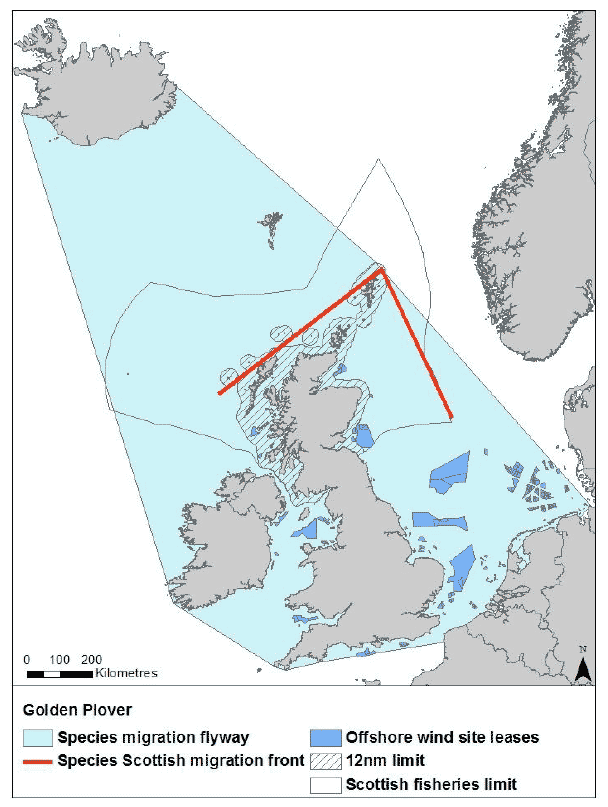
3.87. Golden plover breed throughout upland Scotland from April to August with an estimated 15,000 pairs (Forrester et al. 2007). During winter golden plovers become more coastal and show a tendency to move southwards and gather in flocks, particularly along the east coast of Scotland (Forrester et al. 2007). During winter numbers in Scotland are estimated to be 25,000-35,000 individuals with breeding birds joined by birds migrating predominately from Iceland, with smaller numbers from Scandinavia (Forrester et al. 2007). During the autumn passage (September - October) numbers are estimated to be between 20,000 and 60,000 (Forrester et al. 2007). The spring migration is smaller with 10,000-30,000 individuals estimated to pass through Scotland. It is estimated that 25% of migrating golden plovers fly at collision risk height (Wright et al. 2012). The biogeographic population for northern Europe and Siberia is estimated between 500,000 and 1 million individuals, the Scottish breeding population is approximately 3% of this figure.
Grey plover Pluvialis squatarola
Figure 30 - Migration flyway of grey plover passing Scottish waters
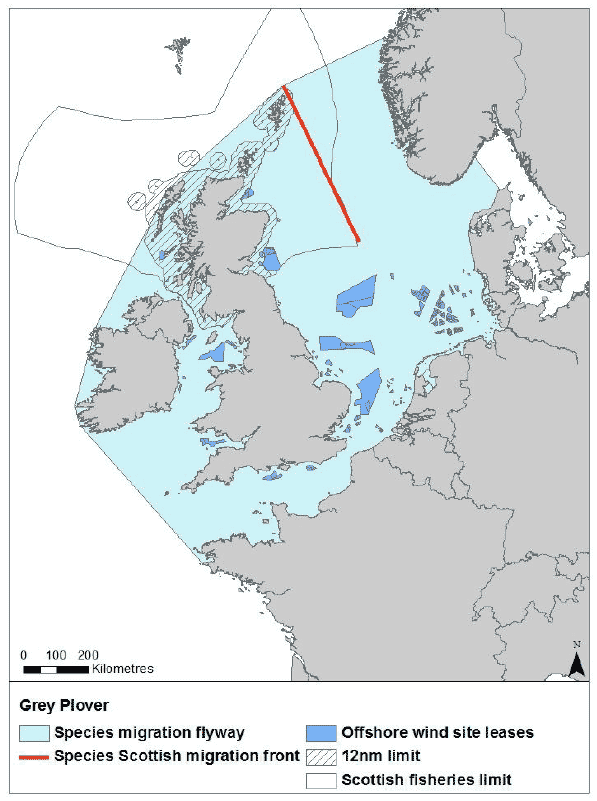
3.88. Grey plover do not breed in Scotland and are only recorded on passage and as a wintering species. Between 1,700-2,800 individuals winter in Scotland (Forrester et al. 2007) and are usually recorded in southern coastal areas on both the east and west of Scotland. The autumn passage occurs between August and October with an estimated 5,000-10,000 individuals passing through Scotland from Western Siberia. Passage migrants from western Siberia can winter as far south as West Africa but can be found throughout Western Europe (Wernham et al. 2002). During the spring migration numbers are lower with 500-2,000 individuals passing through Scotland. It is estimated that 25% of migrating grey plover fly at collision risk height (Wright et al. 2012). The wintering biogeographic population is 247,000 individuals, the Scottish wintering population makes up approximately 1% of this.
Lapwing Vanellus vanellus
3.89. Lapwing are a widespread species in the UK and can be found throughout Scotland during the breeding season. An estimated 71,500-105,600 pairs breed in Scotland between March and July (Forrester et al. 2007). Wintering lapwing have a widespread distribution throughout Scotland and are found in most places with the exception of the northwest, where the species only recorded during the summer. There are estimated to be between 65,000 and 69,000 individuals wintering in Scotland (Forrester et al. 2007). Many of these are likely to be breeding birds though some migration occurs from Fennoscandia and Eastern Europe (Forrester et al. 2007). Numbers of passage migrants are not well known and their collision risk percentage has not been calculated. With similar species, such as grey plovers, it has been estimated that 25% of the migrating individuals fly at collision risk height (Cook et al. 2012). The biogeographic population of lapwings is 5.1 - 8.4 million individuals (Wetlands International, 2012), the Scottish breeding population is around 2% of the higher estimate. Due to a lack of data on numbers in Scotland during spring and autumn passage this species has not been included in collision risk modelling.
Knot Calidris canutus
3.90. Knot do not breed in Scotland but do occur in large numbers as a wintering species. Between 20,400 and 25,800 typically winter in Scotland (Forrester et al. 2007) with the largest congregations in the Solway Firth, the Firth of Forth and the Moray Firth. Information on passage numbers and routes are not well known but the wintering population of the race islandica travel from the Arctic. During passage migration within the UK is common with knot moving between sites in Scotland and England (Wernham et al. 2002). Like other waders it could be assumed that approximately 25% of migrating knot fly at collision risk height (Cook et al. 2012). The estimated biogeographic population of knot is 450,000, the percentage wintering in Scotland could be as much as 5%. Due to a lack of data on numbers in Scotland during spring and autumn passage this species has not been included in collision risk modelling.
Sanderling Calidris alba
Figure 31 - Migration flyway of sanderling passing Scottish waters
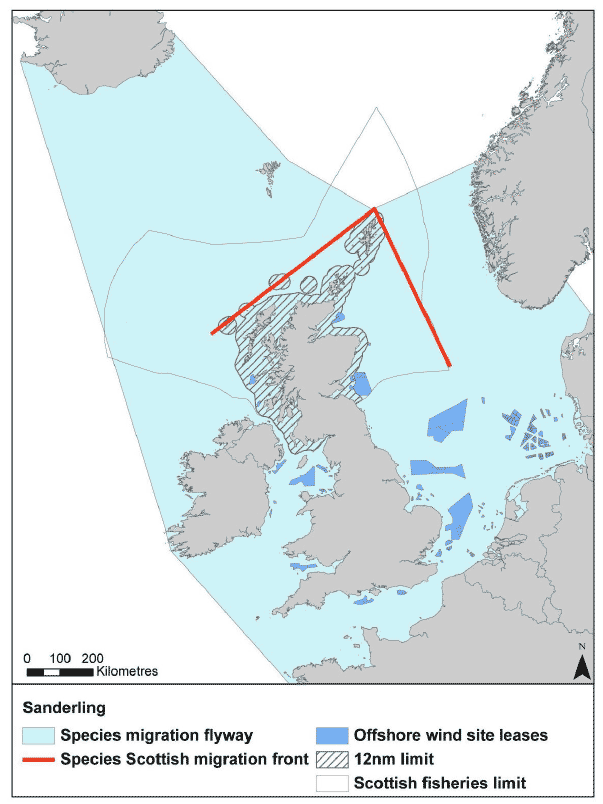
3.91. Sanderling is not a breeding species in Scotland with only wintering and passage birds found on its coasts. 2,800-5,500 individuals winter in Scotland on the southern Outer Hebrides and also along the south eastern coast of the mainland (Forrester et al. 2007). During the autumn migration 30,000-50,000 individuals pass through Scotland from the Arctic with the majority passing on to wintering grounds further south (Africa, Southern Europe). During the spring migration up to 30,000 individuals return through Scotland and can be seen along coastlines on both sides of the country (Forrester et al. 2007). Approximately 25% of migrating sanderling are estimated to fly at collision risk height (Wright et al. 2012). The wintering biogeographic population is estimated at 123,000 individuals in the East Atlantic. The Scottish wintering population is around 4% of this total.
Purple sandpiper Calidris maritima
3.92. Purple sandpiper are common winter visitors to Scotland with 16,000 individuals but only one to five pairs breed in Scotland (Forrester et al. 2007). Breeding for these pairs occurs between May and August with wintering birds occurring from November to May. Wintering birds arrive from Greenland, Canada, Norway and Iceland and can be found along the eastern and south western coast of Scotland. Like other waders it could be assumed that approximately 25% of migrating purple sandpiper fly at collision risk height (Wright et al. 2012). The wintering biogeographic population in the East Atlantic is up to 100,000 individuals so up to 10% can occur in Scotland. Due to a lack of data on numbers in Scotland during spring and autumn passage this species has not been included in collision risk modelling.
Dunlin Calidris alpina aplina, C. alpina schinzii and C. alpina arctica
Figure 32 - Migration flyway of Calidris aplina alpina passing Scottish waters
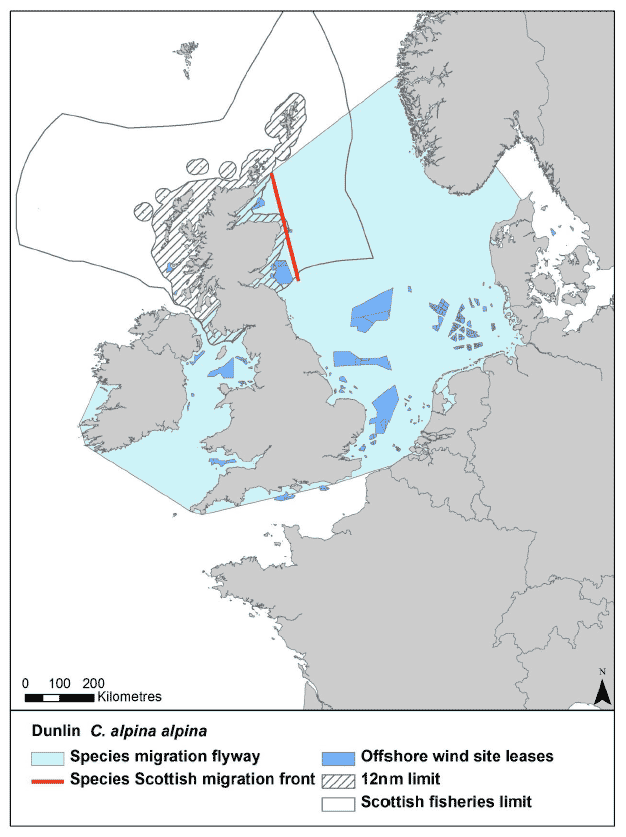
3.93. The nominate subspecies of dunlin, Calidris aplina alpina, is a wintering and passage migrant in Scotland with 37,000-58,000 individuals wintering between November and February (Forrester et al. 2007) Breeding birds from Arctic Fennoscandia and North West Russia migrate between July and September and return from their wintering grounds in Europe and Africa in April and May. The biogeographic wintering population is estimated to be 1,330,000 individuals (Delaney et al. 2009). The number of birds passing through Scottish waters has not previously been estimated in the literature, therefore an approach was agreed with Scottish Natural Heritage so that the species could be modelled. The geographical proportion of the flyway taken up by Scotland was measured and this proportion was applied to the biogeographic wintering population of 1,330,000 (Delaney et al. 2009) This gives an estimated passage population of 340,000. Approximately 25% are estimated to fly at collision risk height (Wright et al. 2012).
Figure 33 - Migration flyway of Calidris aplina schinzii passing Scottish waters
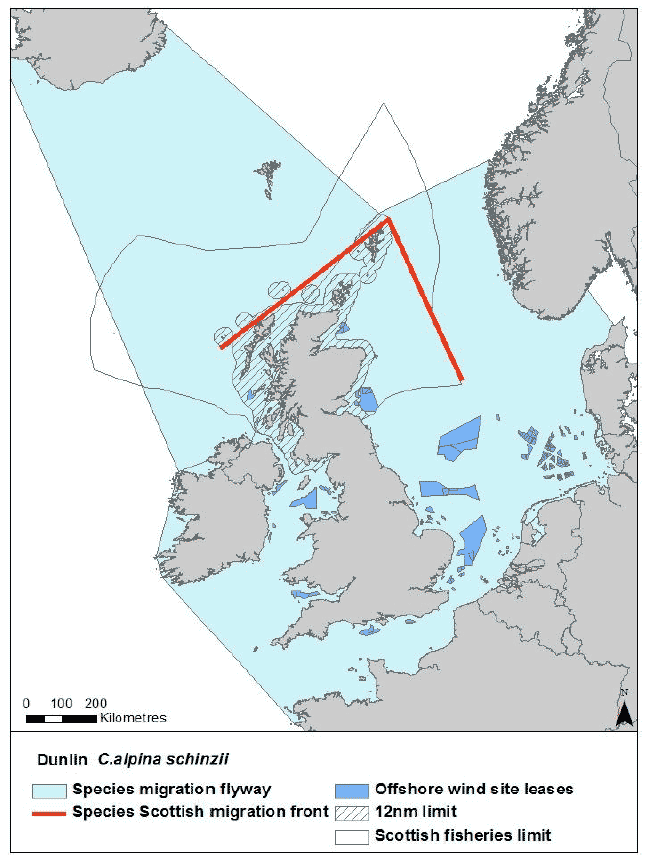
3.94. The subspecies of dunlin Calidris aplina schinzii is a common breeding bird and passage migrant in Scotland with 8,000-10,000 breeding pairs (85% of the UK population) present between April and June (Forrester et al. 2007). Breeding birds from Iceland and Fennoscandia will add to the numbers moving through Scotland in migration in July to September and then on returning to their breeding grounds in April and May. The biogeographic breeding population is estimated to be 990,100 individuals, mostly in Iceland (Delaney et al. 2009). The number of birds passing through Scottish waters has not previously been estimated in the literature, therefore an approach was agreed with Scottish Natural Heritage so that the species could be modelled. The geographical proportion of the flyway taken up by Scotland was measured and this proportion was applied to the biogeographic population of 990,100 (Delaney et al. 2009) This gives an estimated passage population of 218,000. Approximately 25% are estimated to fly at collision risk height (Wright et al. 2012).
Figure 34 - Migration flyway of Calidris aplina arctica passing Scottish waters
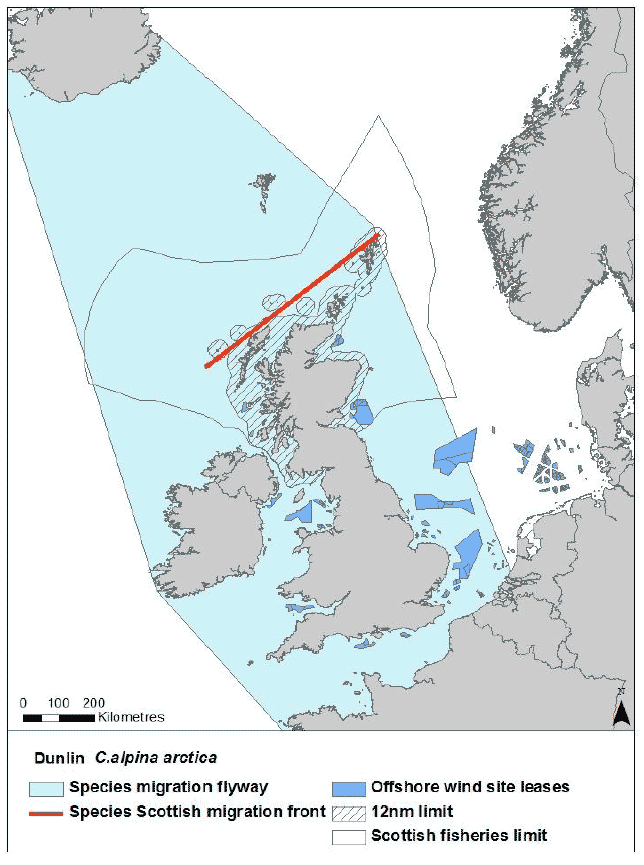
3.95. The subspecies of dunlin Calidris aplina arctica is a passage migrant in Scotland with less than 15,000 thought to occur annually (Forrester et al. 2007). C. aplina arctica breed in Greenland where an estimated 21,000-45,000 (Delaney et al. 2009) migrate South passing through Scotland in August and September and returning in April and May (Forrester et al. 2007). Approximately 25% are estimated to fly at collision risk height (Wright et al. 2012).
Ruff Philomachus pugnax
Figure 35 - Migration flyway of ruff passing Scottish waters
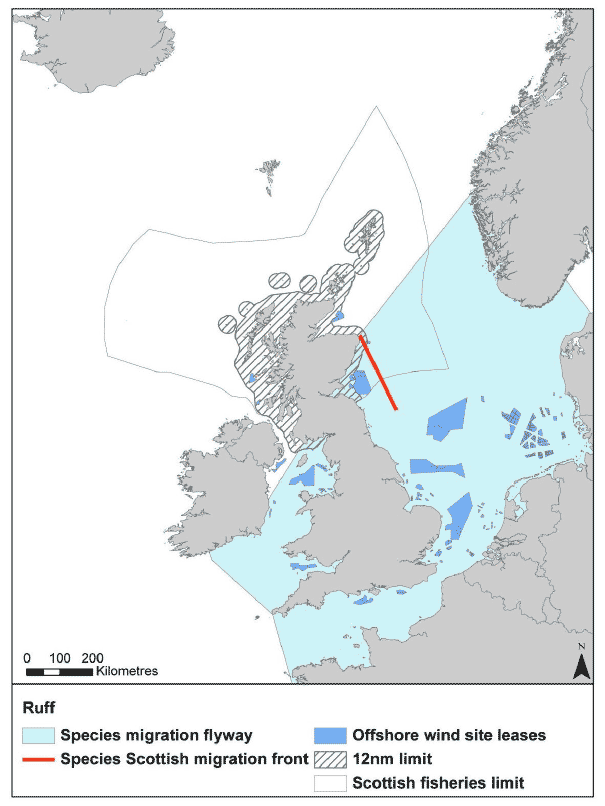
3.96. Only one or two pairs of breeding ruff occur in Scotland with no recent records of birds over wintering. The spring passage of birds returning to Northern Europe and the Arctic is also relatively small with up to 100 birds migrating through Scotland (Forrester et al. 2007). The autumn passage is much larger with up to 2,500 individuals passing through Scotland on the way to wintering grounds in Africa. Migratory ruff tend to stick to the eastern coast of Scotland with a narrow migration corridor (approximately 250km wide) and it is estimated that 25% of ruff fly at collision height (Wright et al. 2012). With a biogeographic wintering population of 1-1.5 million individuals the proportion of ruff migrating through Scotland is very small.
Snipe Gallinago gallinago
Figure 36 - Migration flyway of snipe passing Scottish waters
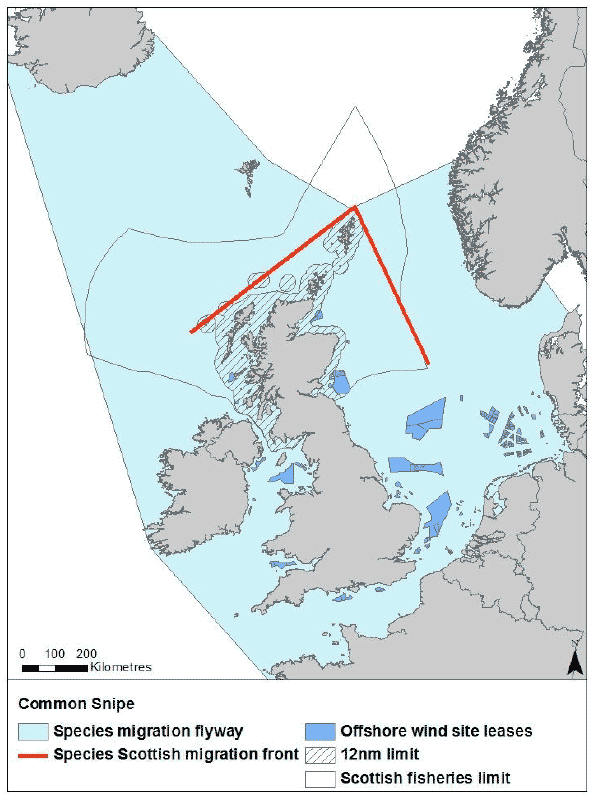
3.97. Snipe breed in large numbers in Scotland with recent estimates totalling 34,000-40,000 pairs (Forrester et al. 2007). Breeding occurs from April in the spring with chicks fledging during August at the latest (Forrester et al. 2007). During winter the population reduces to 10,000-30,000 individuals with the majority of birds migrating to coastal areas and southern parts of Scotland (Wernham et al. 2002). Migratory numbers during spring and autumn a believed to be in excess of 1,000 individuals with individuals from the Faroe Islands, Scandinavia and Northern Europe migrating to or through Scotland in the autumn. It is estimated that 25% of the migratory population are at collision height risk (Wright et al. 2012). The European biogeographic population is greater than 2.5 million individuals (Wetlands International 2012) with the Scottish population contributing 1-2% of the population.Woodcock Scolopax rusticola
Figure 37 - Migration flyway of woodcock passing Scottish waters
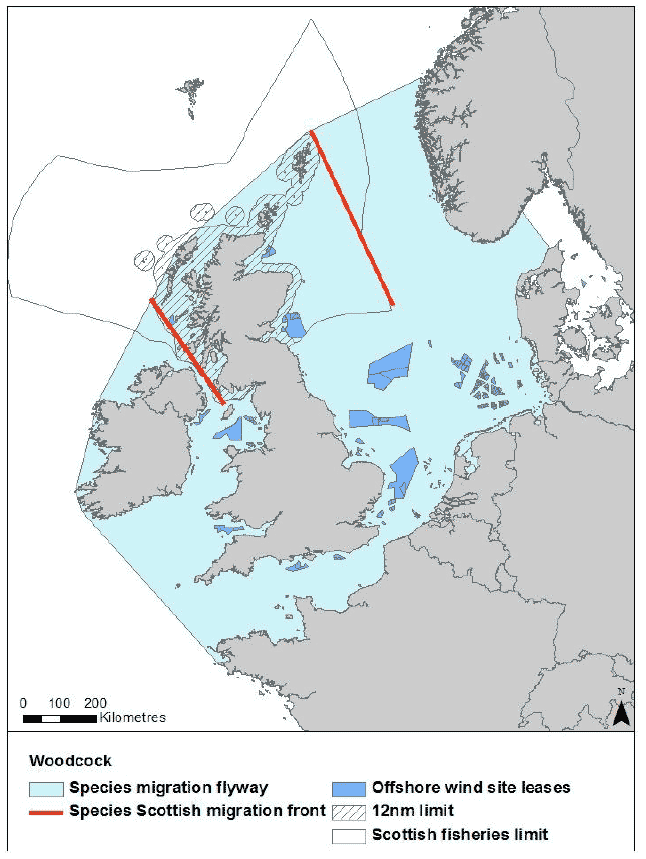
3.98. Woodcock is widespread throughout Scotland with an estimated 24,000-56,500 breeding pairs (Forrester et al. 2007). Their breeding season occurs from March to August. During the winter numbers reach between 78,000 and 167,000 individuals with Scottish woodcock joined by individuals from Fennoscandia. Due to the secretive nature of Woodcock estimates for the biogeographic population in Europe are extremely variable, but the upper limit given in Delaney et al. (2009) is 25,000,000 individuals. The migration corridor is estimated to be quite wide, with the majority of birds arriving from the east before dispersing throughout Scotland (Wernham et al. 2002). The number of birds passing through Scottish waters has not previously been estimated in the literature, therefore an approach was agreed with Scottish Natural Heritage so that the species could be modelled. Firstly it was assumed that 30% of Scottish breeding woodcock (34,000) migrate South West to Ireland in the Autumn and return in Spring. Secondly the geographical proportion of the European flyway taken up by Scotland was measured and this proportion was applied to the biogeographic population of 25,000,000 (Delaney et al. 2009). This gives an estimated winter and passage population of 644,000. Although the reality of Woodcock migration is more complex, these two populations were treated separately so that they could be modelled. It is estimated that 25% of fly at collision risk height (Wright et al. 2012).
Black-tailed godwit Limosa limosa islandica
Figure 38 - Migration flyway of Icelandic black-tailed godwit passing Scottish waters
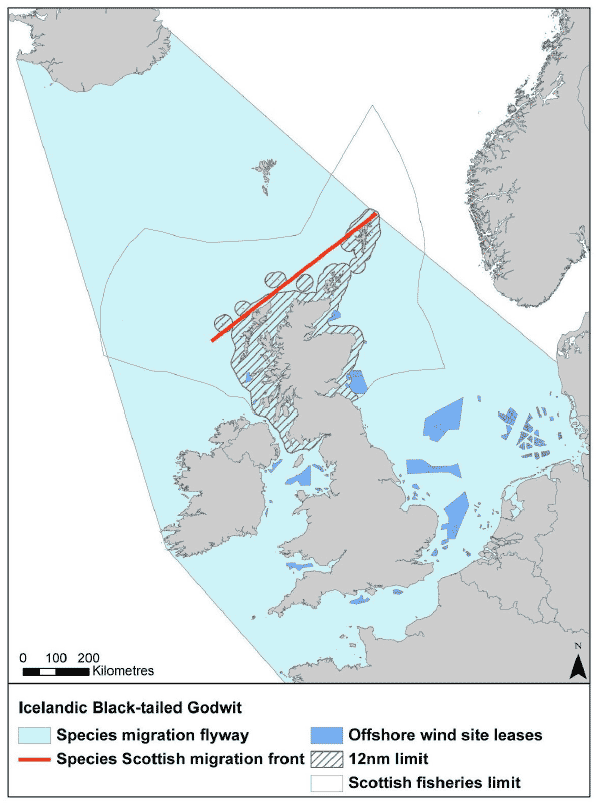
3.99. For this study the collision risk modelling has only considered the Icelandic race of black-tailed godwit Limosa limosa islandica. This race breeds principally in Iceland with small numbers, 5-10 pairs breeding in Scotland (Wernham et al. 2002; Forrester et al. 2007) between April and August. Winter numbers of the race increase to 300-600 individuals with the main autumn passage occurring between July and October. The spring passage occurs between March and May with individuals from Scotland and other parts of the UK passing through Scotland. During both passage periods it may be assumed that all 43,000 birds wintering in Great Britain (Musgrove et al. 2013) potentially pass through Scottish waters en-route to or from Iceland. Autumn migrating birds tend to arrive on the western coast of Scotland though wintering birds are also found on the east coast. During migration it is estimated that 25% of the passage population are flying at collision risk height (Wright et al. 2012). The biogeographic population of the Icelandic race is estimated at 47,000 individuals (Wetlands International 2012). The Scottish wintering population equates to around 1% of this total.
Bar-tailed godwit Limosa lapponica
Figure 39 - Migration flyway of bar-tailed godwit passing Scottish waters
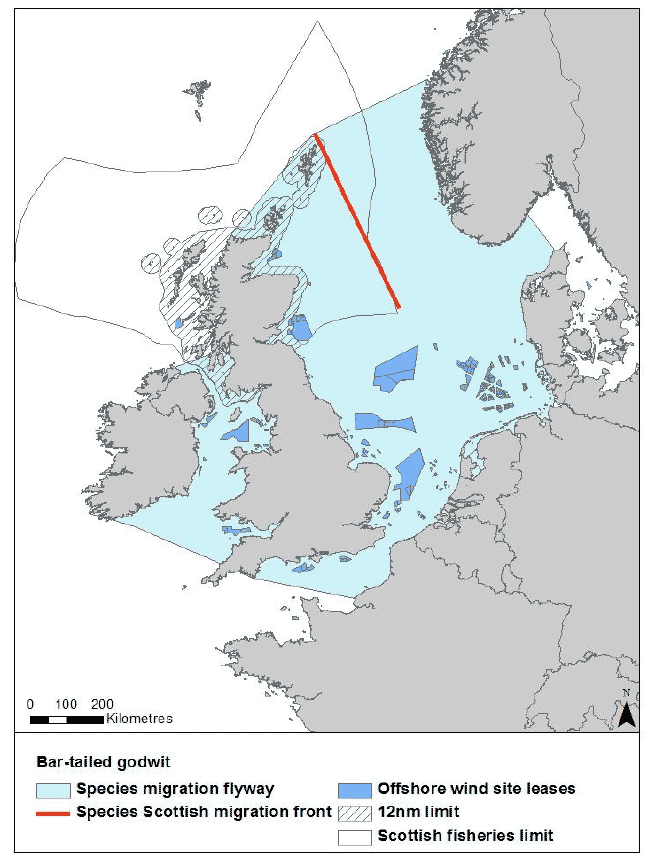
3.100. Bar-tailed godwit is a wintering and passage migrant in Scotland with 10,000-14,000 individuals in winter (Forrester et al. 2007). Large numbers congregate on the Firth of Forth and the Solway Firth in particular. Wintering birds arrive from Scandinavia and Russia from late July onwards and can remain until March (Forrester et al. 2007). The migration front from Europe is quite broad with birds generally arriving on the east coast throughout Britain (Wernham et al. 2002). The wintering biogeographic population is estimated at 120,000 individuals (Wetlands International 2012), meaning that in excess of 10% can winter in Scotland. The number of birds passing through Scottish waters has not previously been estimated in the literature, therefore an approach was agreed with Scottish Natural Heritage so that the species could be modelled. The geographical proportion of the flyway taken up by Scotland was measured and this proportion was applied to the biogeographic population of 120,000 (Delaney et al. 2009). This gives an estimated passage population of 38,000. Approximately 25% are thought to fly at collision risk height (Wright et al. 2012).
Whimbrel Numenius phaeopus
Figure 40 - Migration flyway of whimbrel passing Scottish waters
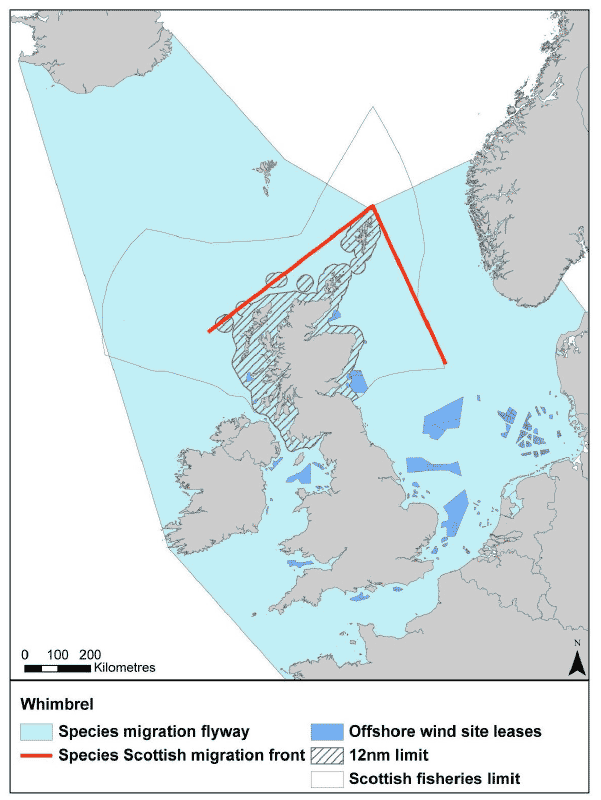
3.101. Breeding whimbrel are largely restricted to Orkney and Shetland in Scotland though some pairs may breed in the northeast in appropriate habitat. 400-500 pairs are found in these areas and their breeding season occurs between April and August. (Forrester et al. 2007). The migration route for breeding birds in Shetland largely takes them south along the east coast of Scotland before heading inland over England (Wernham et al. 2002). Other birds migrating through Scotland during the autumn include breeding birds from Scandinavia, Russia and potentially very large numbers from Iceland. During the spring passage birds returning to breeding grounds pass through Scotland from Ireland, England, South West Europe and West Africa. The biogeographic population is between 600,000 and 750,000 birds (Wetlands International 2012). The number of birds passing through Scottish waters has not previously been estimated in the literature, therefore an approach was agreed with Scottish Natural Heritage so that the species could be modelled. It was assumed that all of the 500,000 breeding birds from Iceland (Birdlife International 2004) could pass through Scottish waters. Approximately 25% are estimated to fly at collision risk height (Wright et al. 2012).
Curlew Numenius arquata
Figure 41 - Migration flyway of curlew passing Scottish waters
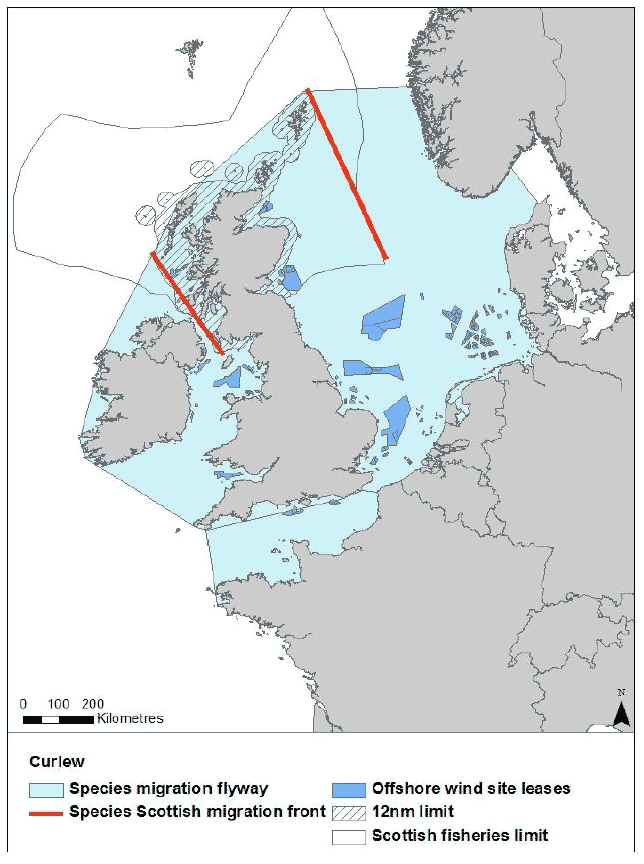
3.102. Curlew is a common breeding bird in Scotland with the highest concentrations in the southern uplands, east Highlands and the Northern Isles. An estimated 58,000 pairs breed in Scotland and have a breeding season that runs from April to August (Forrester et al. 2007). During winter Curlew are found in all coastal areas of Scotland with an estimated 85,000 individuals (Forrester et al. 2007). This will include some Scottish breeding birds as well as migrants from Fennoscandia and Russia. Autumn passage occurs between June and October, spring passage occurs between January and April. The wintering biogeographic population of curlew is up to 1,000,000 birds (Wetlands International 2012) and the Scottish wintering population contributes up to 1% of this. The number of birds passing through Scottish waters has not previously been estimated in the literature, therefore an approach was agreed with Scottish Natural Heritage so that the species could be modelled. It was assumed that all Scottish breeding birds could migrate South West in the autumn and return in the spring. Similarly all Scottish wintering birds were assumed to arrive from North East in autumn and leave in the spring. Although the migratory habits of curlew are more complex than this, for the purposes of the model these two populations are treated independently. 25 % are estimated to fly at collision risk height (Wright et al. 2012).
Greenshank Tringa nebularia
Figure 42 - Migration flyway of greenshank passing Scottish waters
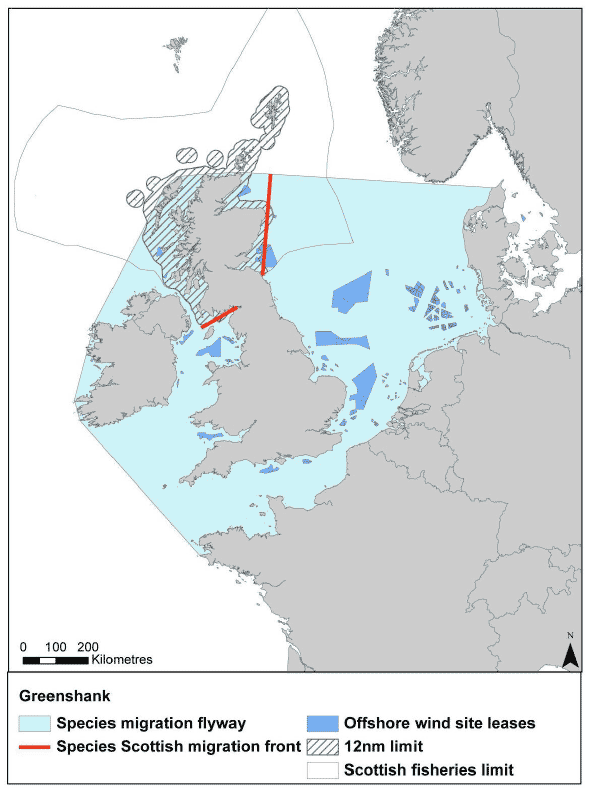
3.103. Greenshank breed in the north and west of Scotland in boggy moorland areas and around peatland pools. There are between 720 and 1,480 pairs and their breeding season occurs between March and July (Forrester et al. 2007). During the winter only small numbers remain in Scotland with 50-90 individuals remaining in coastal areas of southern Scotland (Forrester et al. 2007). Autumn passage occurs between August and September with between 500-1,500 individuals passing through Scotland. This included the Scottish breeding birds and also individuals that have bred in Fennoscandia (Forrester et al. 2007). Spring passage, between March and May is generally smaller with 10-50 individuals passing through as they return from wintering grounds in Ireland, England, south west Europe and north west Africa. The majority of migration occurs along the west coast with an estimated 25% of greenshanks flying at collision risk height (Wright et al. 2012). The wintering biogeographic population for greenshank is between 190,000 and 270,000 of which the Scottish population makes up less than 1%.
Wood sandpiper Tringa glareola
Figure 43 - Migration flyway of wood sandpiper passing Scottish waters
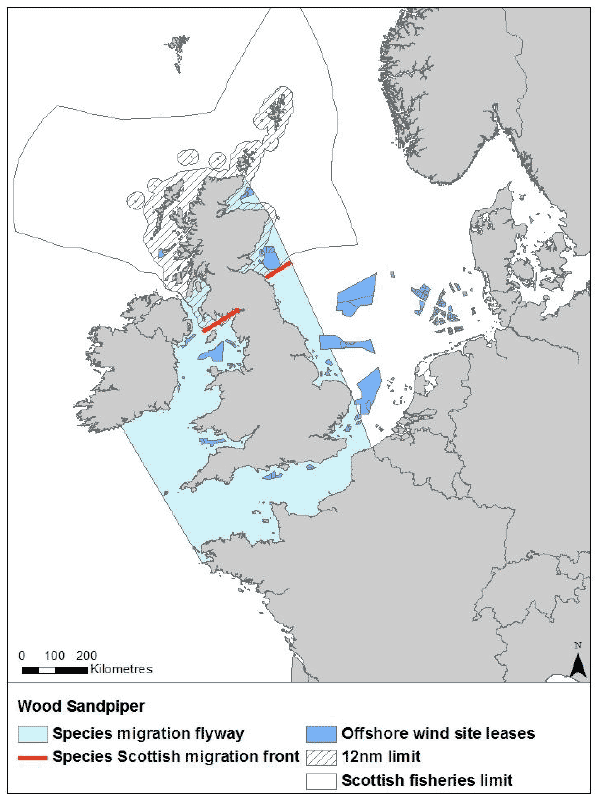
3.104. Wood sandpiper are a scarce breeder in Scotland; only 18-21 pairs breed in the Scottish Highlands during a short breeding season between May and July. Wood sandpiper do not winter in Scotland with breeding birds migrating to their wintering grounds in West Africa (Forrester et al. 2007). It is estimated that 25% of migrating wood sandpiper are at collision risk height (Wright et al. 2012). The biogeographic population of wood sandpiper is estimated to be between 900,000 and 1.2 million (Wetlands International 2012) of which the Scottish population makes up a very small percentage.
Redshank Tringa totanus robusta and T. tetanus totanus
Figure 44 - Migration flyway of T. totanus robusta passing Scottish waters
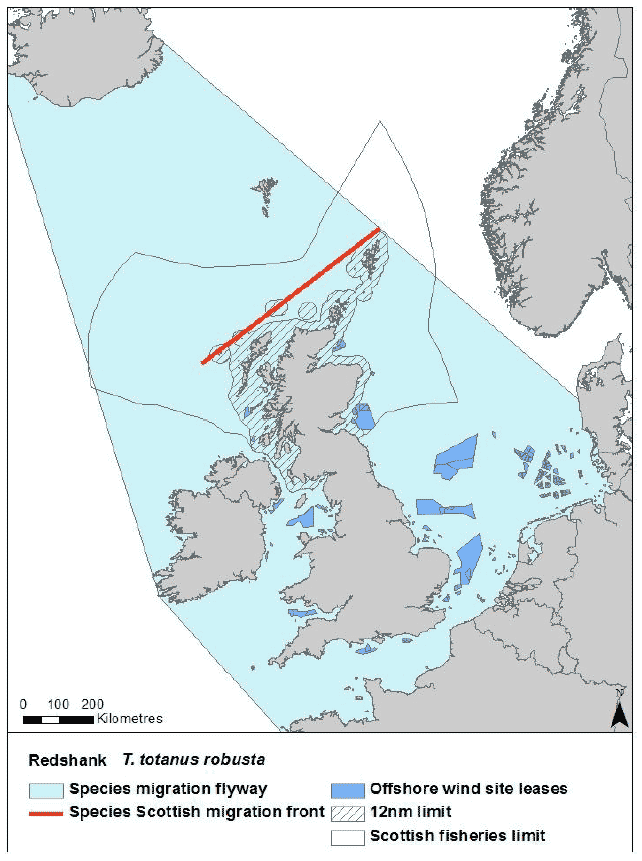
3.105. The Icelandic redshank, T. totanus robusta, is a common wintering and passage visitor in Scotland with 20,000-45,000 birds wintering, mostly on the estuaries between September and April (Forrester et al. 2007). Migrants leaving Iceland will pass through Scotland between June and August and return between March and April. In agreement with Scottish Natural Heritage, the total number of birds passing through Scottish waters was estimated by using the geographical proportion of the European flyway taken up by Scotland and applying this proportion to the European population of 400,000 (Delaney et al. 2009). Approximately 25% are estimated to fly at collision risk height (Wright et al. 2012).
Figure 45 - Migration flyway of T. totanus totanus passing Scottish waters
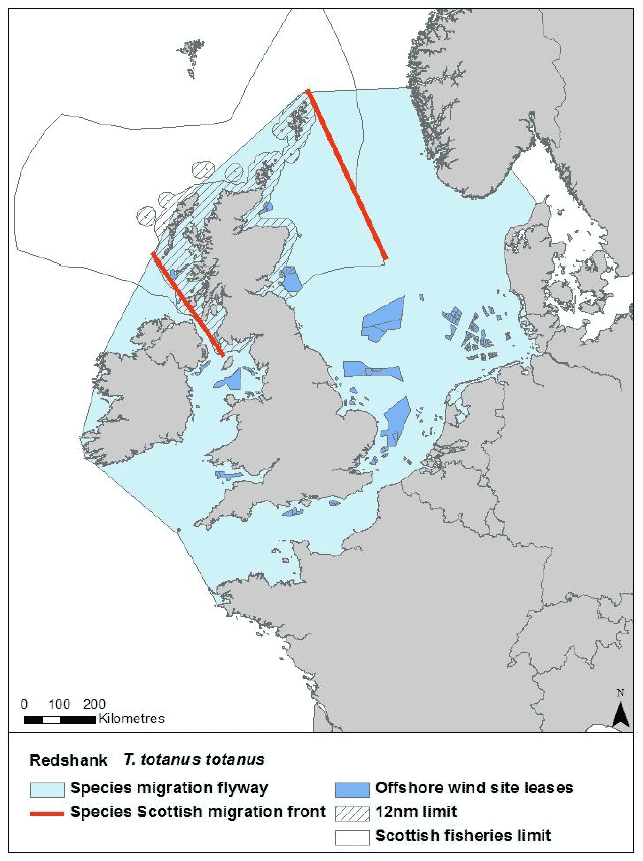
3.106. The nominate subspecies of redshank, T. totanus totanus, is a common breeding and passage bird in Scotland with 11,700-17,500 pairs breeding between March and June (40% of the UK breeding population) and 4,000-25,000 individuals wintering between September and April (Forrester et al. 2007). Migrants from Fennoscandia, Russia and Eastern Europe arrive between June and August and return in March or April. The number of birds passing through Scottish waters has not previously been estimated in the literature, therefore an approach was agreed with Scottish Natural Heritage so that the subspecies could be modelled. It was assumed that all Scottish breeding birds could migrate South West in the autumn and return in the spring. Similarly all Scottish wintering birds were assumed to arrive from the East in the autumn and return in the spring. Although the migratory habits of redshank are more complex than this, for the purposes of the model these two populations are treated independently. Approximately 25 % are estimated to fly at collision risk height (Wright et al. 2012).
Turnstone Arenaria interpres
Figure 46 - Migration flyway of turnstone passing Scottish waters
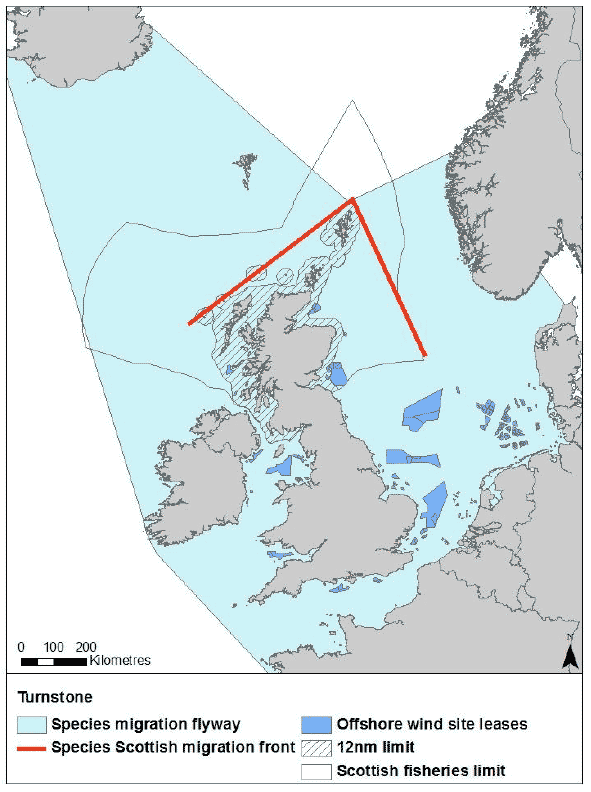
3.107. Turnstone do not breed in Scotland, however it supports 35,300 birds which winter between August and May. Spring passage occurs between February and May and involves 20,000 to 50,000 individuals from UK, European and African populations. Autumn passage involves similar numbers of birds from the same populations and occurs between July and August (Forrester et al. 2007). Of the migrating birds an estimated 25% fly at collision risk height (Wright et al. 2012). It is estimated that between 100,000 and 200,000 birds are present in the north east Canada and Greenland populations (Wetlands International 2012).
Red-necked phalarope Phalaropus lobatus
Figure 47 - Migration flyway of red-necked phalarope passing Scottish waters
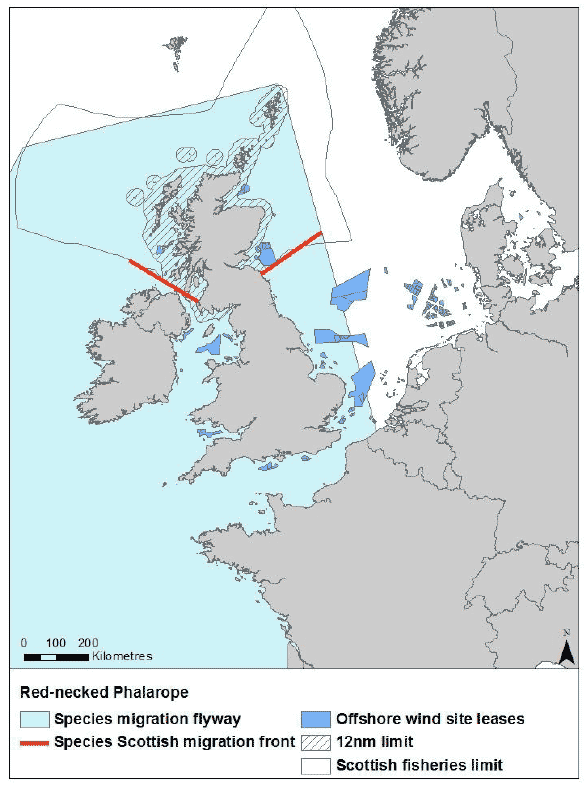
3.108. Between 13 and 48 pairs of birds breed in Scotland between May and August. No birds winter in the country. Birds are fairly scarce on spring passage with between 0-10 recorded each year between May and June. Autumn migration records are slightly higher with between 0-15 birds usually recorded between June and September (Forrester et al. 2007). Of the birds migrating, an estimated 25% fly at collision risk height (Wright et al. 2012). It has been estimated that 1,000,000 birds overwinter in north west Eurasia (Wetlands International 2012).
Analyses
Seabirds
3.109. Within the migration corridors shown in Figures 2 to 4, seabirds were modelled as either being distributed evenly across the entire width ( i.e. a uniform probability distribution) or more concentrated towards the shore (using a negative binomial distribution). The negative binomial distribution used peaked at approximately 25% of the width across the coastal strip with a tail to the offshore edge of the strip. Discussions with members of the project Steering Committee indicated that while the former of these approaches ('uniform') was a reasonable assumption, there were situations under which some species may fly closer to shore ( e.g. during less favourable weather). Hence the use of two alternative distributions (uniform and negative binomial) permits exploration of the sensitivity of the results to the assumptions about flight distributions.
3.110. Integration was used to calculate the proportional overlap between each wind farm listed in Table 1 and each coastal strip (0 - 10km, 0 - 20km, etc.). This was undertaken for both migration front width distributions (uniform and negative binomial) for each of the three coast coastal proximities (near / mid /far), hence six combinations for each coastal strip ( e.g. for the 0 - 10km coastal strip, uniform-near, uniform-mid, uniform-far, negative binomial-near, negative binomial-mid and negative binomial-far).
3.111. The overlap between each wind farm and each migration corridor was measured perpendicularly across the migration corridor, along a line extending offshore at 90° from the coast. This can be visualised as the width of a wind farm as would be seen by a bird flying parallel to the coast within the migration corridor.
3.112. During the collision risk modelling (details below) the number of individuals of each species estimated to be at risk of collision at each wind farm was calculated as the passage population ( Table 2) multiplied by the proportional overlap of the wind farm and that species' coastal strip.
Table 2 - Seabird passage populations, estimated proportions passing along each Scottish coast, assigned coastal strip and overall percent of species estimated to fly at rotor height
| Seabird species | Passage population | Approximate proportion on each coast |
Coastal strip (km) | Percent estimated at collision height (Cook et al. 2012) |
||
|---|---|---|---|---|---|---|
| Spring | Autumn | West | East | |||
| Red-throated diver | 10,000 | 10,000 | 0.75 | 0.25 | 0 - 20 | 2 |
| Black-throated diver | 1,000 | 1,000 | 0.8 | 0.2 | 0 - 20 | 0.1 |
| Great northern diver | 3,000 | 3,000 | 0.6 | 0.4 | 0 - 40 | 2 |
| Fulmar | 1,000,000 | 1,000,000 | 0.7 | 0.3 | 0 - 60 | 0.2 |
| European storm-petrel | 100,000 | 200,000 | 0.9 | 0.1 | 0 - 60 | 1 |
| Leach's storm-petrel | 200,000 | 500,000 | 0.9 | 0.1 | 0 - 60 | 1 |
| Northern gannet | 400,000 | 600,000 | 0.5 | 0.5 | 0 - 40 | 9.6 |
| Great cormorant | 7,000 | 10,000 | 0.25 | 0.75 | 0 - 10 | 12.4 |
| European shag | 70,000 | 70,000 | 0.4 | 0.6 | 0 - 10 | 12.4 |
| Arctic skua | 5,000 | 10,000 | 0.5 | 0.5 | 0 - 20 | 3.8 |
| Great skua | 30,000 | 30,000 | 0.5 | 0.5 | 0 - 40 | 4.3 |
| Pomarine skua | 3,000 | 2,000 | 0.7 | 0.3 | 0 - 40 | 5 |
| Long-tailed skua | 1,000 | 1,000 | 0.7 | 0.3 | 0 - 60 | 5 |
| Black-legged kittiwake | 1,000,000 | 1,000,000 | 0.6 | 0.4 | 0 - 60 | 15.7 |
| Black-headed gull | 120,000 | 120,000 | 0.3 | 0.7 | 0 - 60 | 7.9 |
| Common gull | 300,000 | 300,000 | 0.3 | 0.7 | 0 - 20 | 22.9 |
| Little gull | 400 | 3,000 | 0.1 | 0.9 | 0 - 20 | 5.5 |
| Lesser black-backed gull | 50,000 | 80,000 | 0.3 | 0.7 | 0 - 20 | 25.2 |
| Herring gull | 50,000 | 50,000 | 0.3 | 0.7 | 0 - 20 | 28.4 |
| Great black-backed gull | 10,000 | 10,000 | 0.3 | 0.7 | 0 - 20 | 33.1 |
| Little tern | 600 | 600 | 0.2 | 0.8 | 0 - 10 | 5 |
| Sandwich tern | 3,000 | 5,000 | 0.2 | 0.8 | 0 - 10 | 3.6 |
| Common tern | 20,000 | 20,000 | 0.3 | 0.7 | 0 - 10 | 12.7 |
| Arctic tern | 200,000 | 200,000 | 0.4 | 0.6 | 0 - 10 | 2.8 |
| Common guillemot | 2,000,000 | 2,000,000 | 0.5 | 0.5 | 0 - 20 | 0.01 |
| Razorbill | 250,000 | 250,000 | 0.5 | 0.5 | 0 - 20 | 0.4 |
| Atlantic puffin | 1,000,000 | 1,000,000 | 0.7 | 0.3 | 0 - 60 | 0.1 |
Non-seabird species
3.113. Migration corridor widths for non-seabird species passing Scottish coastal waters were assumed for this study to comprise the cross-sectional width of the Scottish coast perpendicular to the species flyway or flyways (superimposed as close to the coast as possible). These are shown as red bars on the migration flyway maps for each species (Figures 5 to 47).
3.114. During the collision risk modelling (details below) the number of individuals of each species estimated to be at risk of collision at each wind farm was calculated as the passage population ( Table 3) multiplied by the proportional overlap of each wind farm and that species' migration corridor width.
Table 3 - Non-seabird species' passage populations, estimated proportions passing along each Scottish coast, estimated migration corridor width and overall percent of species estimated to fly at rotor height
| Non-seabird species | Passage population | Approximate proportion on each coast |
Migration corridor width (km) |
Percent estimated at collision height (Wright et al. 2012) |
||
|---|---|---|---|---|---|---|
| Spring | Autumn | West | East | |||
| Whooper swan | 22,000 | 22,000 | 0.7 | 0.3 | 622.0 | 50 |
| Taiga bean goose | 350 | 350 | 0 | 1 | 196.5 | 30 |
| Pink footed goose | 360,000 | 360,000 | 0.3 | 0.7 | 620.6 | 30 |
| Greenland white fronted goose | 13,000 | 13,000 | 0.9 | 0.1 | 482.7 | 30 |
| Icelandic greylag goose | 111,500 | 111,500 | 0.1 | 0.35 | 814.2 | 30 |
| Greenland barnacle goose | 58,000 | 58,000 | 1 | 0 | 513.7 | 30 |
| Svalbard barnacle goose | 33,000 | 33,000 | 0 | 1 | 297.6 | 30 |
| Canadian light bellied brent goose | 600 | 1,300 | 1 | 0 | 458.2 | 30 |
| Svalbard light bellied brent goose | 50 | 300 | 0 | 1 | 671.0 | 30 |
| Wigeon | 214,000 | 214,000 | 0.5 | 0.5 | 1140 | 15 |
| Teal | 100,000 | 100,000 | 0.5 | 0.5 | 1140 | 15 |
| Pintail | 22,000 | 22,000 | 0.5 | 0.5 | 1139.2 | 15 |
| Pochard | 6,000 | 6,000 | 0.25 | 0.75 | 445.4 | 15 |
| Tufted duck | 213,000 | 213,000 | 0.75 | 0.25 | 1134.6 | 15 |
| Scaup | 8,000 | 8,000 | 0.75 | 0.25 | 1101.1 | 15 |
| Long-tailed duck | 15,000 | 15,000 | 0.25 | 0.75 | 1104.1 | 15 |
| Common scoter | 100,000 | 100,000 | 0.9 | 0.1 | 1140 | 1 |
| Velvet scoter | 1000 | 1000 | 0.1 | 0.9 | 533.9 | 15 |
| Hen harrier | 640 | 640 | 0.20 | 0. | 872.1 | 50 |
| Osprey | 400 | 700 | 0.25 | 0.4 | 127.3 | 50 |
| Kestrel | 1,000 | 1,000 | 0.5 | 0.5 | 776.0 | 50 |
| Corncrake | 2,396 | 10,660 | 0.8 | 0.1 | 210.0 | 50 |
| Oystercatcher | 80,000 | 80,000 | 0.5 | 0.5 | 1138.6 | 25 |
| Golden plover | 30,000 | 60,000 | 0.5 | 0.5 | 1124.2 | 25 |
| Grey plover | 2,000 | 10,000 | 0.6 | 0.4 | 531.0 | 25 |
| Dotterel | 3,000 | 3,000 | 0 | 1 | 533.0 | 25 |
| Whimbrel | 500,000 | 500,000 | 0.5 | 0.5 | 620 | 25 |
| Curlew (breeding) | 116,000 | 116,000 | 1 | 0 | 380 | 25 |
| Curlew (wintering) | 85,700 | 85,700 | 0 | 1 | 520 | 25 |
| Black tailed godwit Icelandic | 43,000 | 43,000 | 0.6 | 0.4 | 620 | 25 |
| Bar tailed godwit | 38,000 | 38,000 | 0.2 | 0.8 | 520 | 25 |
| Turnstone | 50,000 | 50,000 | 0.6 | 0.4 | 1165.8 | 25 |
| Ruff | 100 | 2500 | 0 | 1 | 254.3 | 25 |
| Sanderling | 30,000 | 50,000 | 0.6 | 0.4 | 1158.0 | 25 |
| Dunlin ( alpina) | 340,000 | 340,000 | 0.5 | 0.5 | 520 | 25 |
| Dunlin ( schinzii) | 218,000 | 218,000 | 0.5 | 0.5 | 1140 | 25 |
| Dunlin ( arctica) | 15,000 | 15,000 | 0.5 | 0.5 | 620 | 25 |
| Red necked phalarope | 10 | 15 | 0.6 | 0.4 | 479.5 | 25 |
| Greenshank | 50 | 1,500 | 0.75 | 0.25 | 441.8 | 25 |
| Wood sandpiper | 50 | 50 | 0.15 | 0.85 | 219.1 | 25 |
| Redshank ( robusta) | 140,000 | 140,000 | 0.5 | 0.5 | 620 | 25 |
| Redshank ( totanus) breeding | 35,000 | 35,000 | 0.5 | 0.5 | 380 | 25 |
| Redshank ( totanus) passage | 25,000 | 25,000 | 0 | 1 | 520 | 25 |
| Woodcock (breeding) | 34,000 | 34,000 | 1 | 0 | 380 | 25 |
| Woodcock (wintering) | 644,000 | 644,000 | 1 | 0 | 520 | 25 |
| Snipe | 1,000 | 1,000 | 0.6 | 0.4 | 1165.8 | 25 |
Collision risk modelling
3.115. The migration extension of the most up to date offshore collision risk model (Band 2012) was used to calculate spring and autumn mortality estimates for all species listed in Table 4 (seabirds) and Table 5 (non-seabirds). This update to the collision methods incorporates three model options for calculating collision probability. Option 1 calculates the probability of collision assuming that birds at collision height are evenly distributed across the entire rotor altitude ( i.e. from lower rotor tip height to upper rotor tip height). Option 3 uses modelled flight height distribution estimates (currently only available for seabird species, Band 2012), generated from analysis of large combined datasets. This takes into account the fact that (for most species), as altitude increases, the proportion of individuals present decreases. Option 3 uses numerical integration to calculate the probability of collision using the flight height data and turbine specifications (hub height and rotor radius). Option 2 calculates the probability of collision using the Option 1 assumption of an even distribution of flights across rotor altitude, but adjusts the proportion estimated to be at collision height using the modelled flight height data (Band 2012).
3.116. For those seabird species for which flight height data are available (Cook et al. 2012) all three model options were used. For seabird species lacking flight height data and for non seabird species only Option 1 was used.
3.117. The modelled flight height data includes confidence intervals around the median flight heights. These were used in the collision modelling for Options 2 and 3 to acknowledge the uncertainty in flight heights. Thus the collision estimates for Options 2 and 3 include 95% confidence intervals. Seabird biometrics used in the collision modelling are provided in Table 4 and terrestrial species biometrics are provided in Table 5. An avoidance rate of 98% was assumed for all collision estimates generated during this assessment.
3.118. For seabirds the passage population was adjusted to account for collisions at each wind farm, on the assumption that each wind farm modelled was encountered in order, from north to south in autumn and vice versa in spring. This removed from the calculations the possibility of individuals being 'killed' multiple times. This adjustment used the 98% avoidance rate mortality. No such adjustment was made for non-seabird species, since these birds were modelled as crossing the offshore wind farms on broad fronts which encompassed all the wind farms within their migration corridor. Thus, non-seabird species' populations were modelled as if each individual was only at risk of encountering one Scottish wind farm. This contrasted with the seabird approach which explicitly allowed for the fact that individuals could encounter several Scottish wind farms whilst on migration (but could only collide once).
3.119. Summary of steps for estimating collision mortality:
- The seasonal (spring/autumn) passage population was split into east and west components using the proportions in Tables 2 and 3;
- Seabirds: the passage population was multiplied by the proportional overlap between each wind farm in turn and the species' migration corridor;
- Terrestrial: the passage population was multiplied by the average width of each wind farm divided by the species' migration front ( i.e. to obtain the proportion of the population passing through each wind farm);
- Application of the Band (2012) migrant collision risk model to the population passing through the wind farm ( i.e. calculation of rotor transits, probability of collision etc. using Option 1) to estimate numbers in collision. For seabirds with height data, Band (2012) Option 3 also applied; and
- Individual wind farm collision estimates summed for each species.
3.120. The above steps were conducted for each species in turn and separately for spring and autumn passage. The final results presented here are the sum of the spring and autumn estimates.
Table 4 - Seabird dimensions and flight speed. Flight speeds from Alerstam et al. (2007), bird dimensions from Snow and Perrins (1998)
| Seabird species | Body length (m) | Wingspan (m) | Flight speed (ms -1) |
|---|---|---|---|
| Red-throated diver | 0.73 | 1.30 | 17.0 |
| Black-throated diver | 0.73 | 1.30 | 17.0 |
| Great northern diver | 0.80 | 1.37 | 18.7 |
| Fulmar | 0.475 | 1.07 | 13.0 |
| European storm-petrel | 0.18 | 0.39 | 12.0 |
| Leach's storm-petrel | 0.22 | 0.48 | 12.0 |
| Gannet | 0.935 | 1.725 | 14.9 |
| Cormorant | 1.00 | 1.6 | 15.2 |
| Shag | 0.73 | 0.98 | 15.2 |
| Pomarine skua | 0.51 | 1.38 | 15.2 |
| Arctic skua | 0.435 | 1.18 | 13.8 |
| Long-tailed skua | 0.53 | 1.17 | 13.6 |
| Great skua | 0.585 | 1.50 | 14.9 |
| Atlantic puffin | 0.275 | 0.55 | 17.6 |
| Razorbill | 0.38 | 0.655 | 16.0 |
| Common guillemot | 0.395 | 0.67 | 19.1 |
| Sandwich tern | 0.41 | 1.05 | 11.0 |
| Common tern | 0.35 | 0.98 | 11.0 |
| Arctic tern | 0.34 | 0.80 | 10.9 |
| Little tern | 0.24 | 0.55 | 11.0 |
| Kittiwake | 0.39 | 1.075 | 13.1 |
| Black-headed gull | 0.37 | 1.10 | 11.9 |
| Little gull | 0.26 | 0.78 | 11.59 |
| Common gull | 0.41 | 1.20 | 13.5 |
| Lesser black-backed gull | 0.58 | 1.42 | 13.1 |
| Herring gull | 0.61 | 1.44 | 12.8 |
| Great black-backed gull | 0.71 | 1.57 | 13.7 |
Table 5 - Non seabird dimensions and flight speed. Flight speeds from Alerstam et al. (2007), bird dimensions from Snow and Perrins (1998)
| Non seabird species | Body length (m) | Wingspan (m) | Flight speed (ms -1) |
|---|---|---|---|
| Whooper swan | 1.60 | 2.43 | 17.3 |
| Taiga bean goose | 0.84 | 1.75 | 17.3 |
| Pink footed goose | 0.75 | 1.70 | 17.1 |
| Greenland white fronted goose | 0.75 | 1.70 | 16.1 |
| Icelandic greylag goose | 0.90 | 1.80 | 17.1 |
| Greenland barnacle goose | 0.70 | 1.45 | 17.0 |
| Svalbard barnacle goose | 0.70 | 1.45 | 17.0 |
| Canadian light bellied brent goose | 0.61 | 1.20 | 16.7 |
| Svalbard light bellied brent goose | 0.61 | 1.20 | 16.7 |
| Wigeon | 0.51 | 0.86 | 20.6 |
| Teal | 0.38 | 0.64 | 19.7 |
| Pintail | 0.66 | 0.95 | 21.3 |
| Pochard | 0.49 | 0.82 | 23.6 |
| Tufted duck | 0.47 | 0.73 | 21.1 |
| Scaup | 0.51 | 0.84 | 21.3 |
| Long-tailed duck | 0.47 | 0.79 | 22.0 |
| Common scoter | 0.54 | 0.90 | 22.1 |
| Velvet scoter | 0.58 | 0.99 | 20.1 |
| Hen harrier | 0.52 | 1.20 | 9.1 |
| Osprey | 0.58 | 1.70 | 13.3 |
| Kestrel | 0.35 | 0.80 | 10.1 |
| Corncrake | 0.28 | 0.50 | 10.0 |
| Oystercatcher | 0.45 | 0.86 | 13.0 |
| Golden plover | 0.29 | 0.76 | 13.7 |
| Grey plover | 0.30 | 0.83 | 17.9 |
| Dotterel | 0.22 | 0.64 | 19.5 |
| Whimbrel | 0.42 | 0.89 | 16.3 |
| Curlew | 0.60 | 1.00 | 16.3 |
| Black tailed godwit Icelandic | 0.44 | 0.82 | 18.3 |
| Bar tailed godwit | 0.39 | 0.80 | 18.3 |
| Turnstone | 0.24 | 0.57 | 14.9 |
| Ruff | 0.3 | 0.58 | 13.6 |
| Sanderling | 0.21 | 0.45 | 20.1 |
| Dunlin | 0.2 | 0.43 | 15.3 |
| Red necked phalarope | 0.19 | 0.41 | 13.1 |
| Greenshank | 0.33 | 0.7 | 12.3 |
| Wood sandpiper | 0.21 | 0.57 | 9.6 |
| Redshank | 0.29 | 0.66 | 12.3 |
| Woodcock | 0.34 | 0.58 | 9.8 |
| Snipe | 0.27 | 0.47 | 17.1 |
Contact
There is a problem
Thanks for your feedback